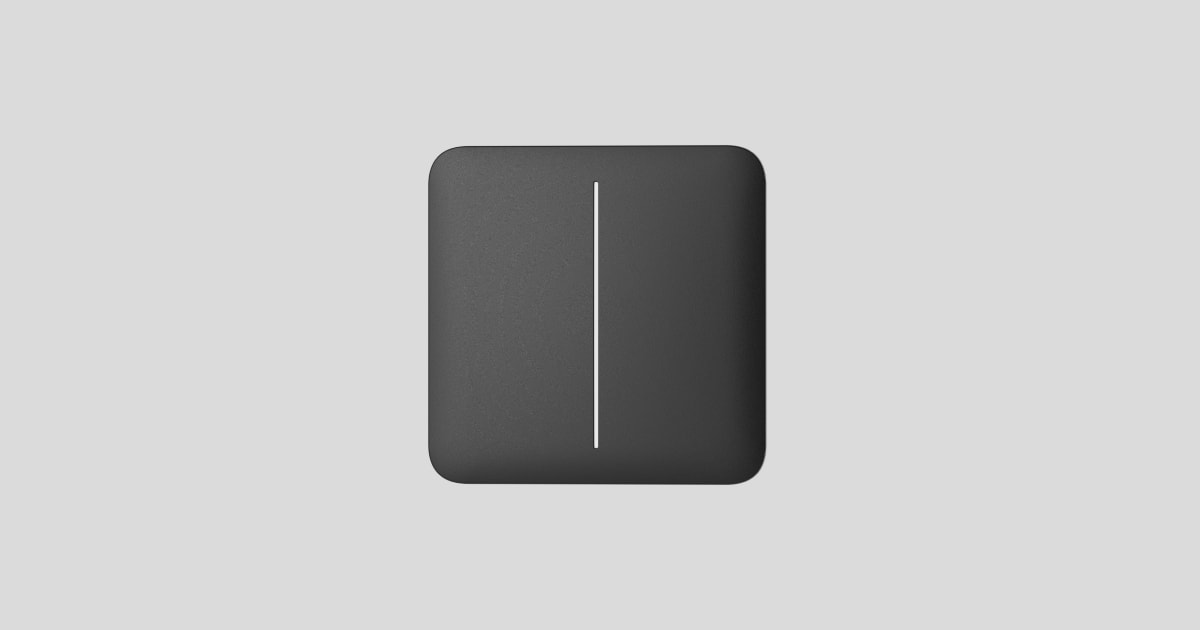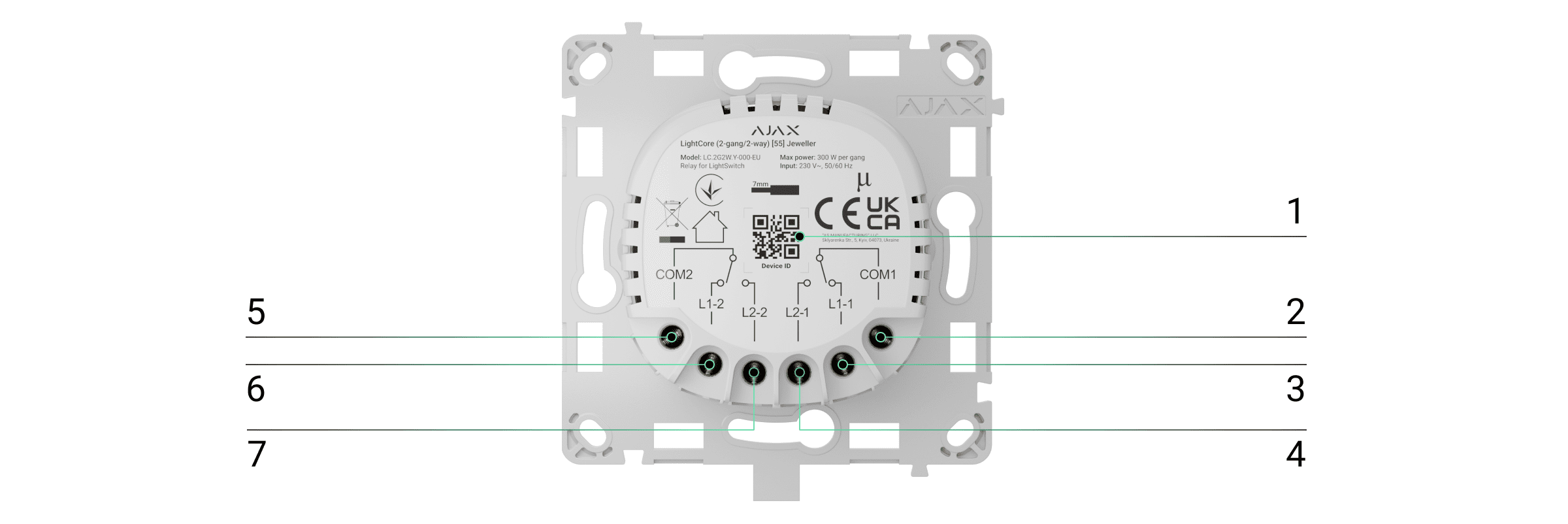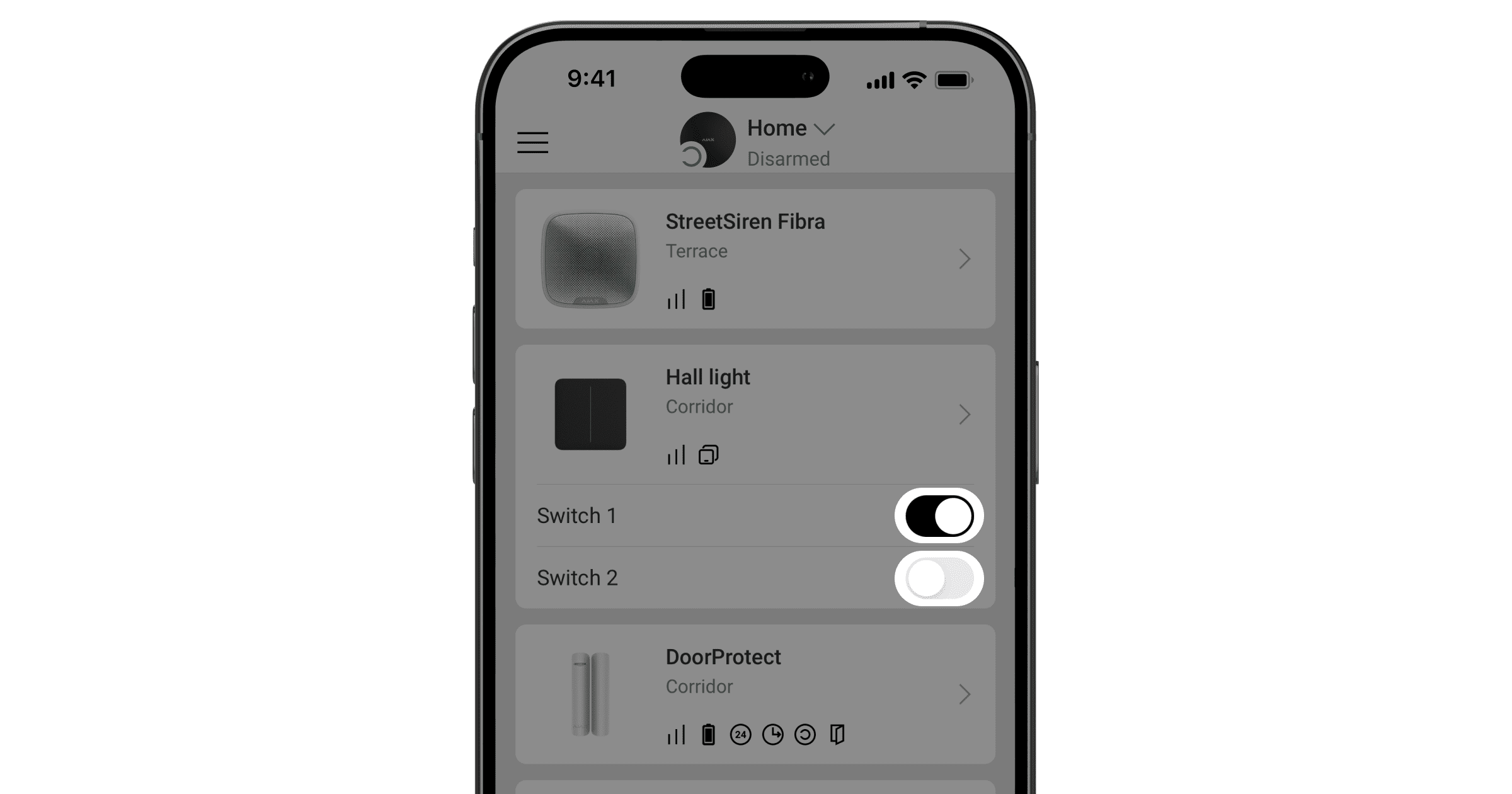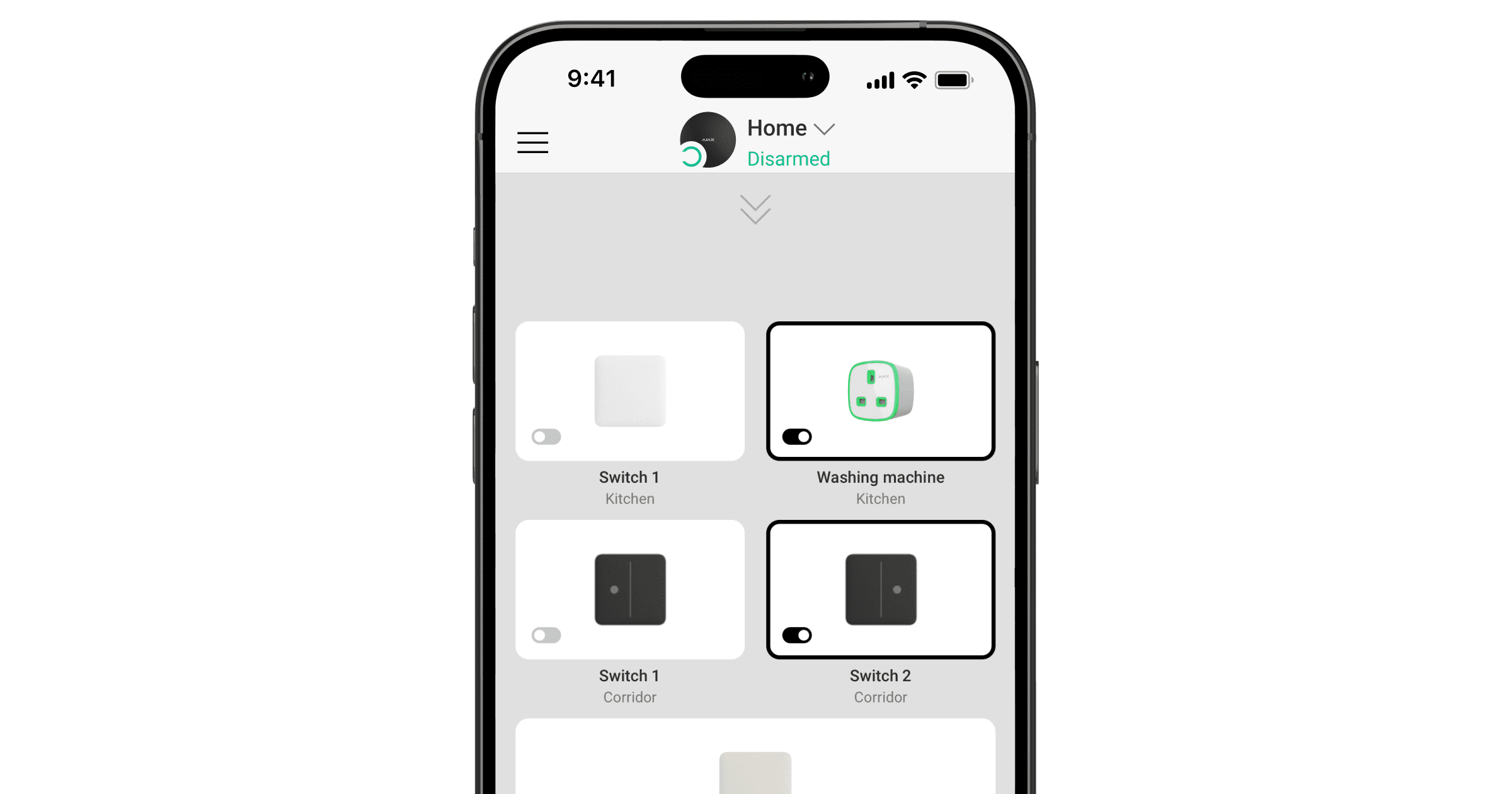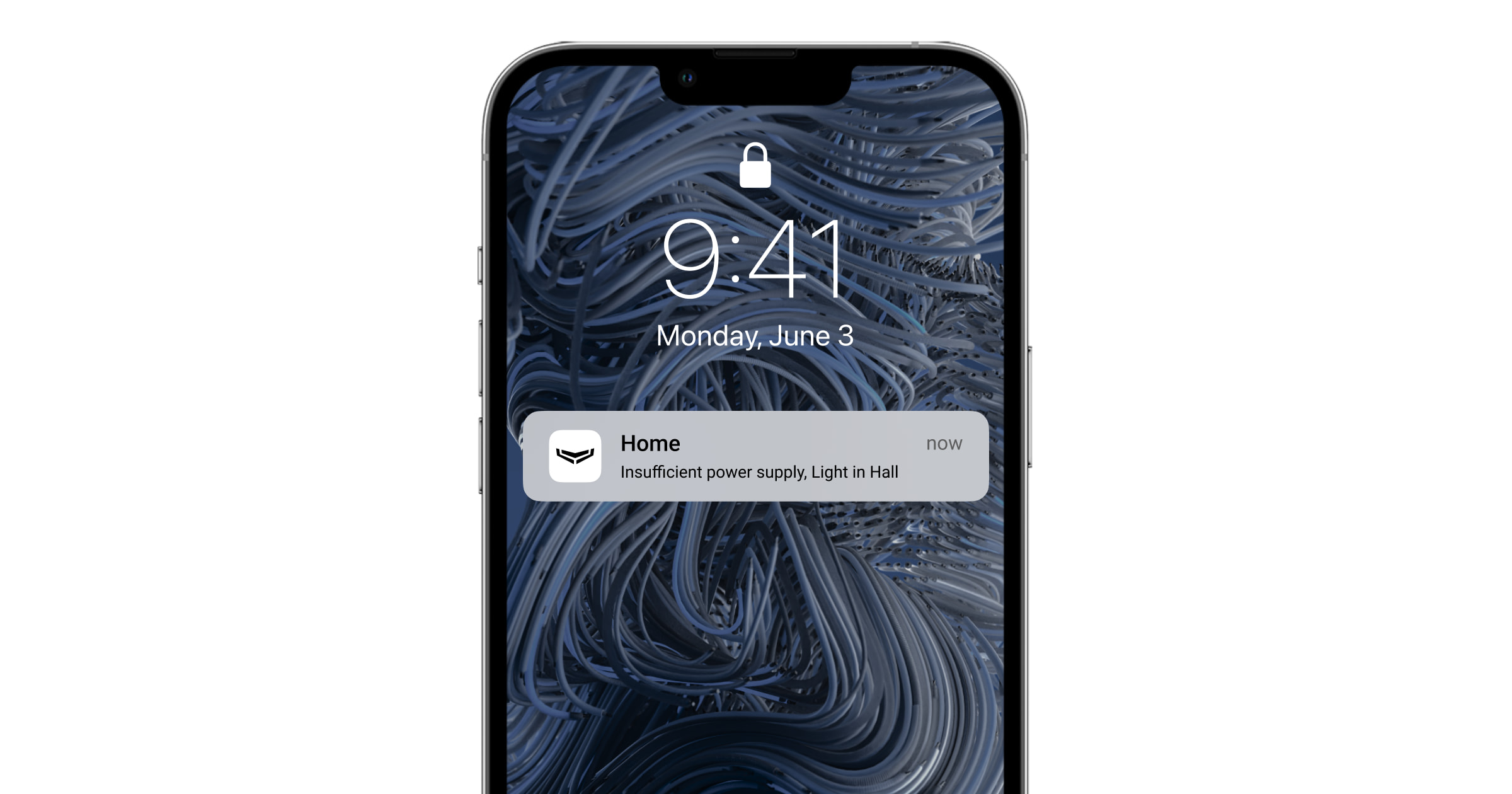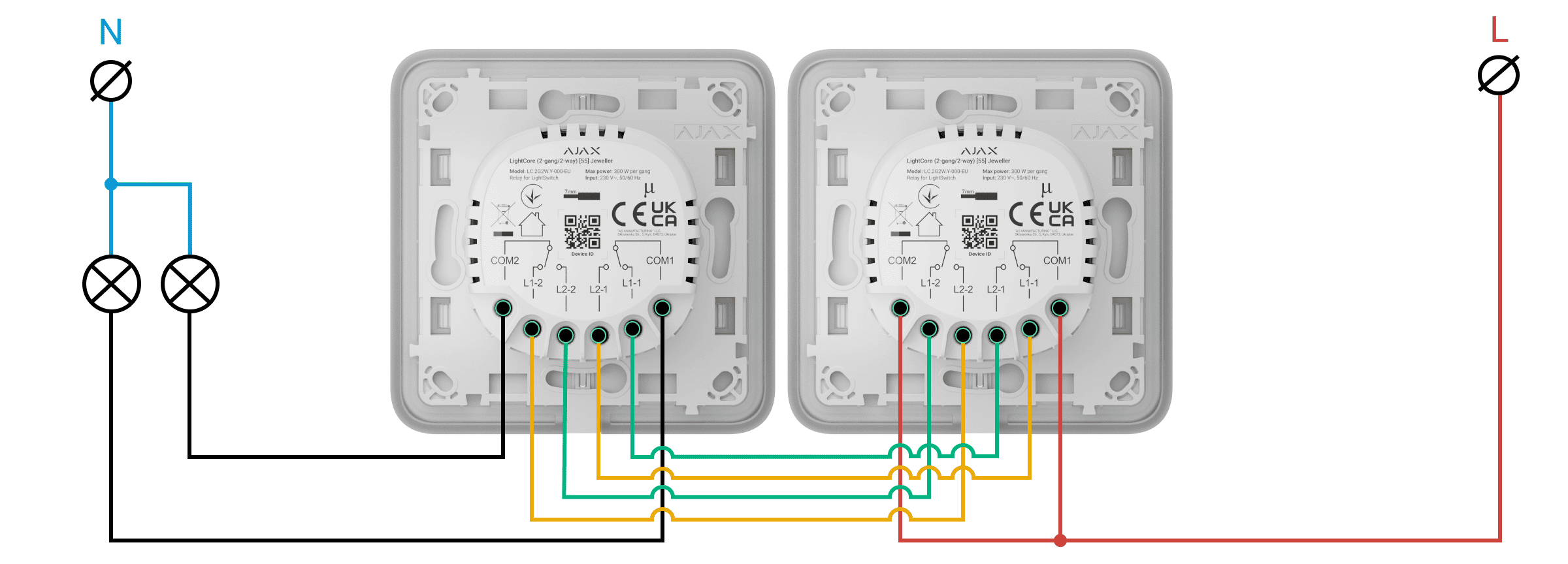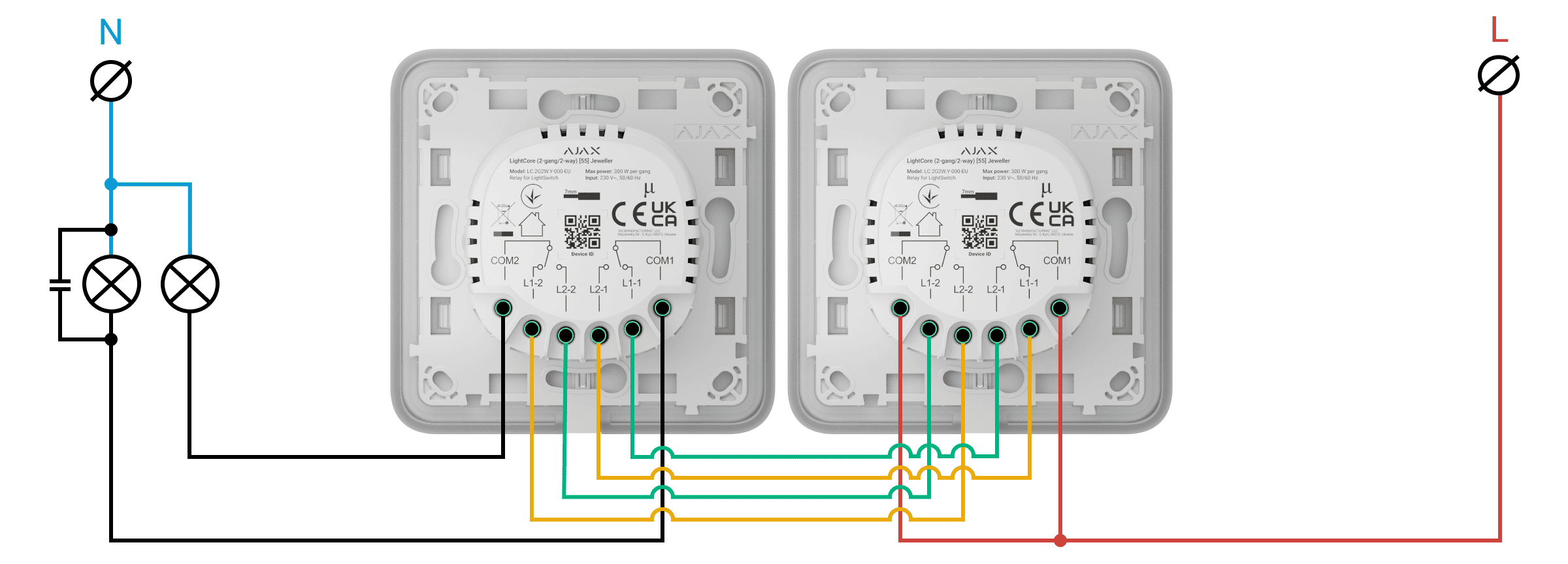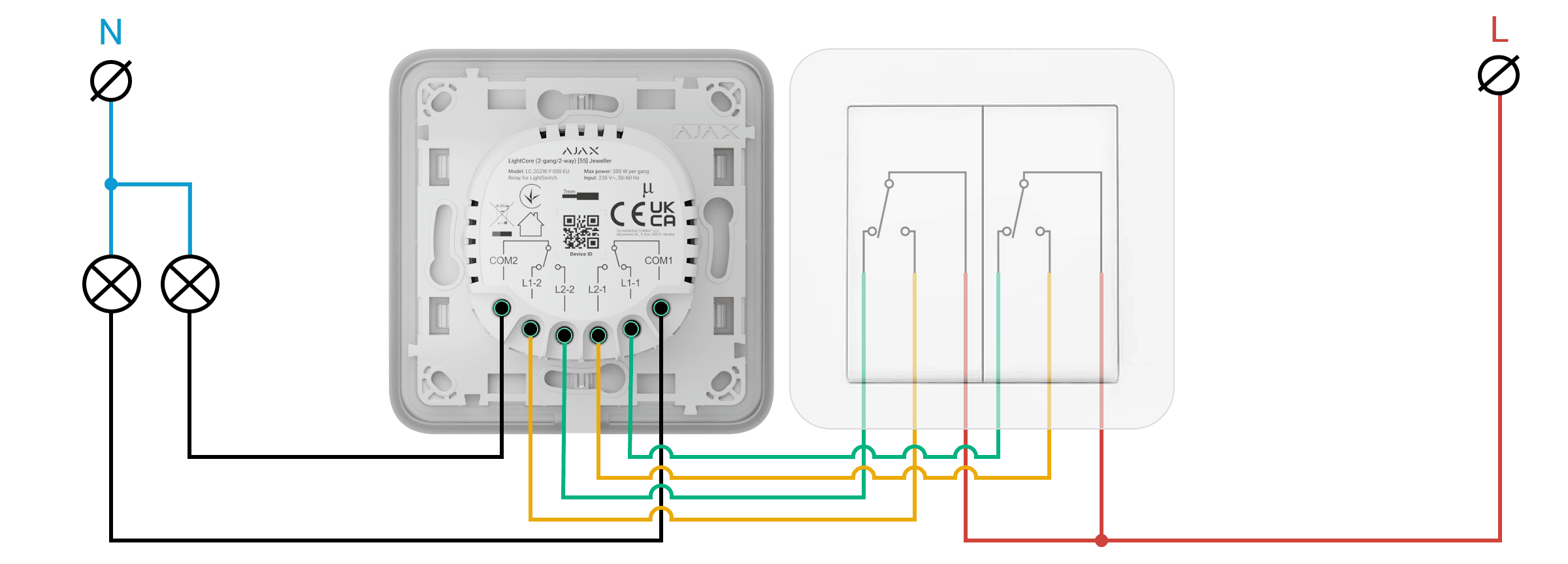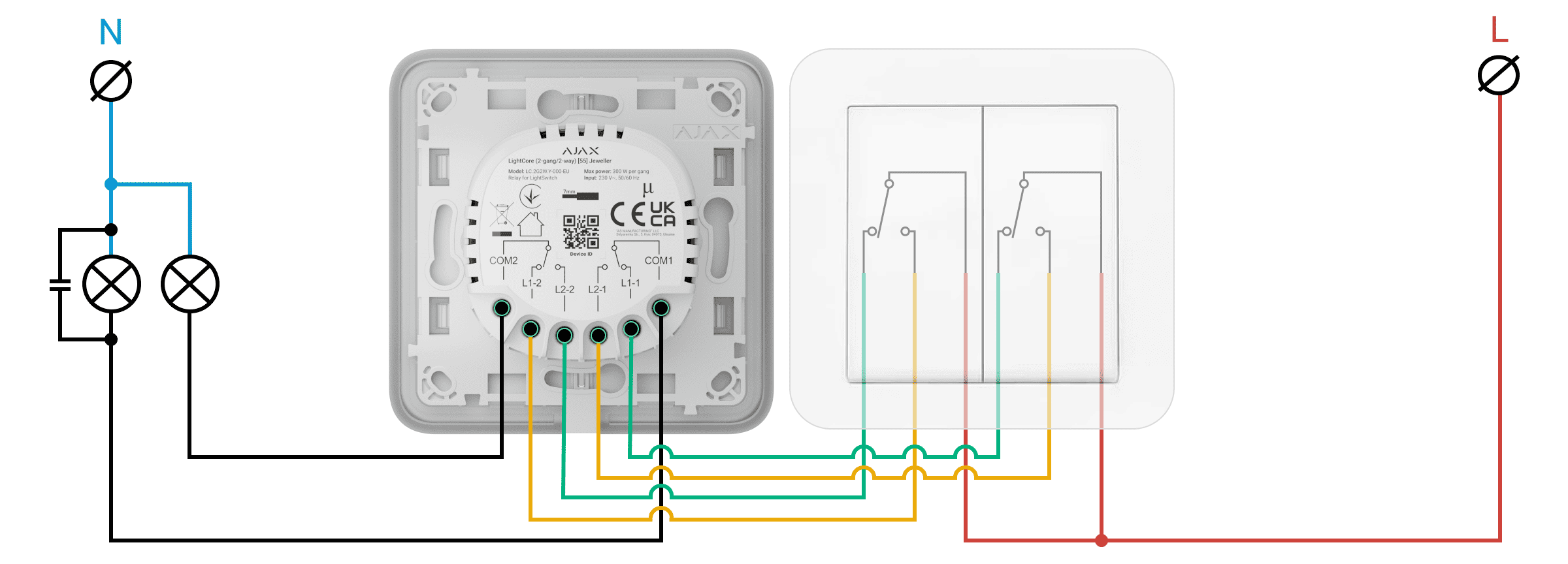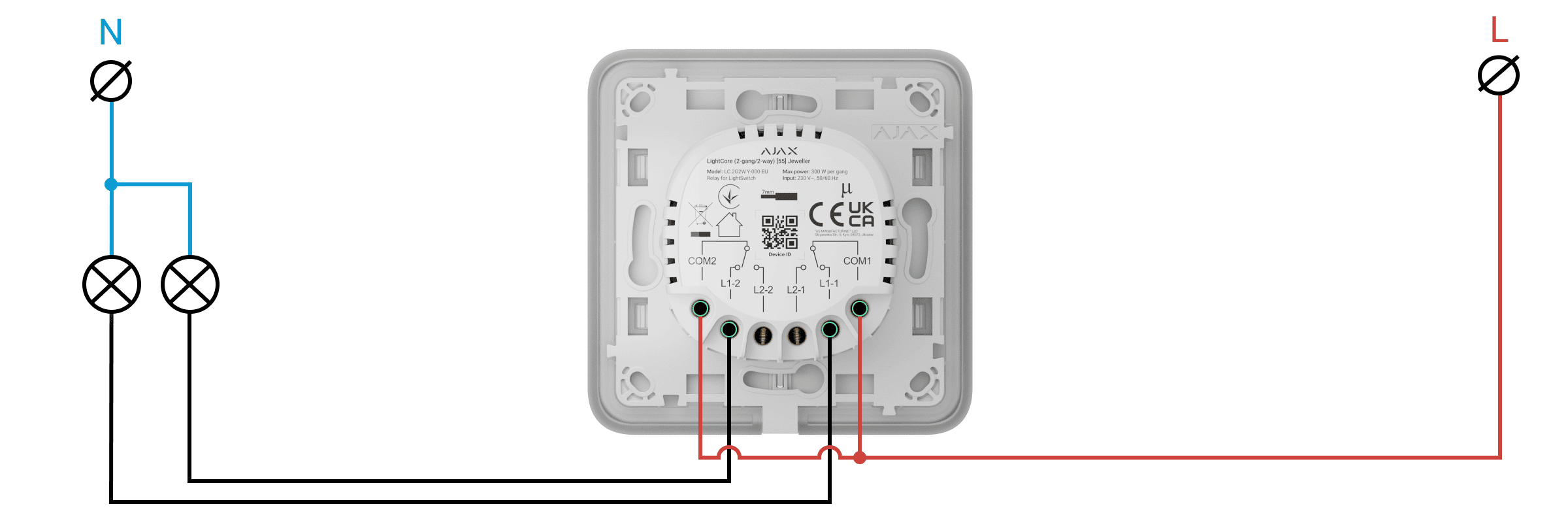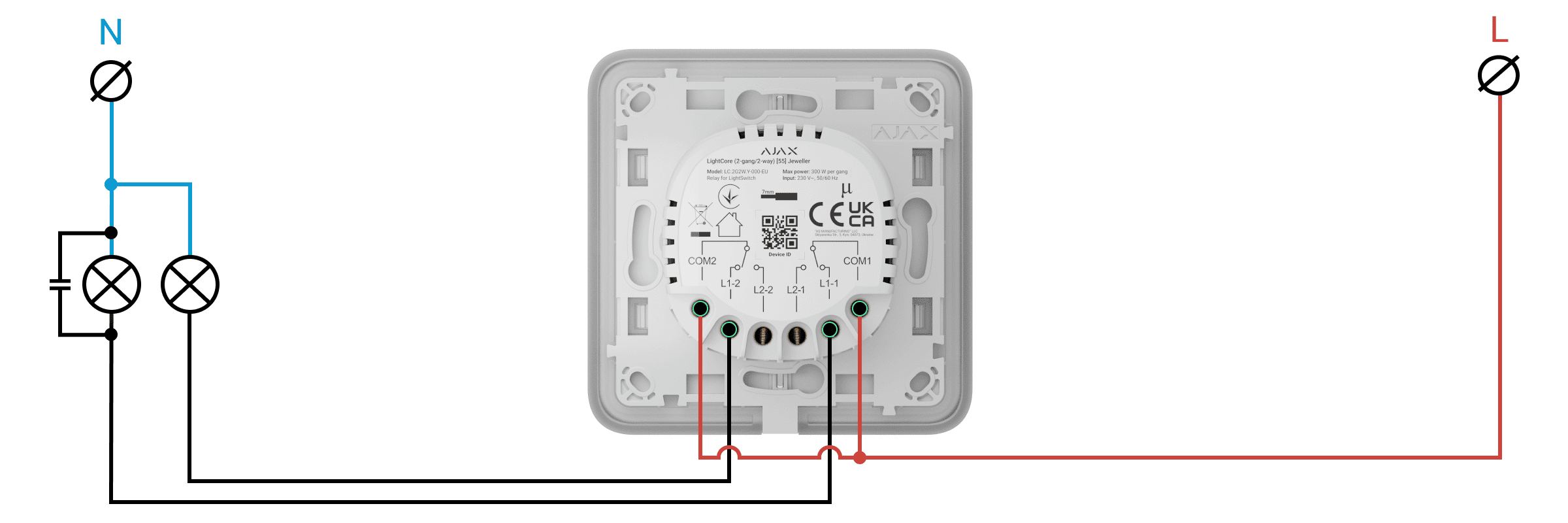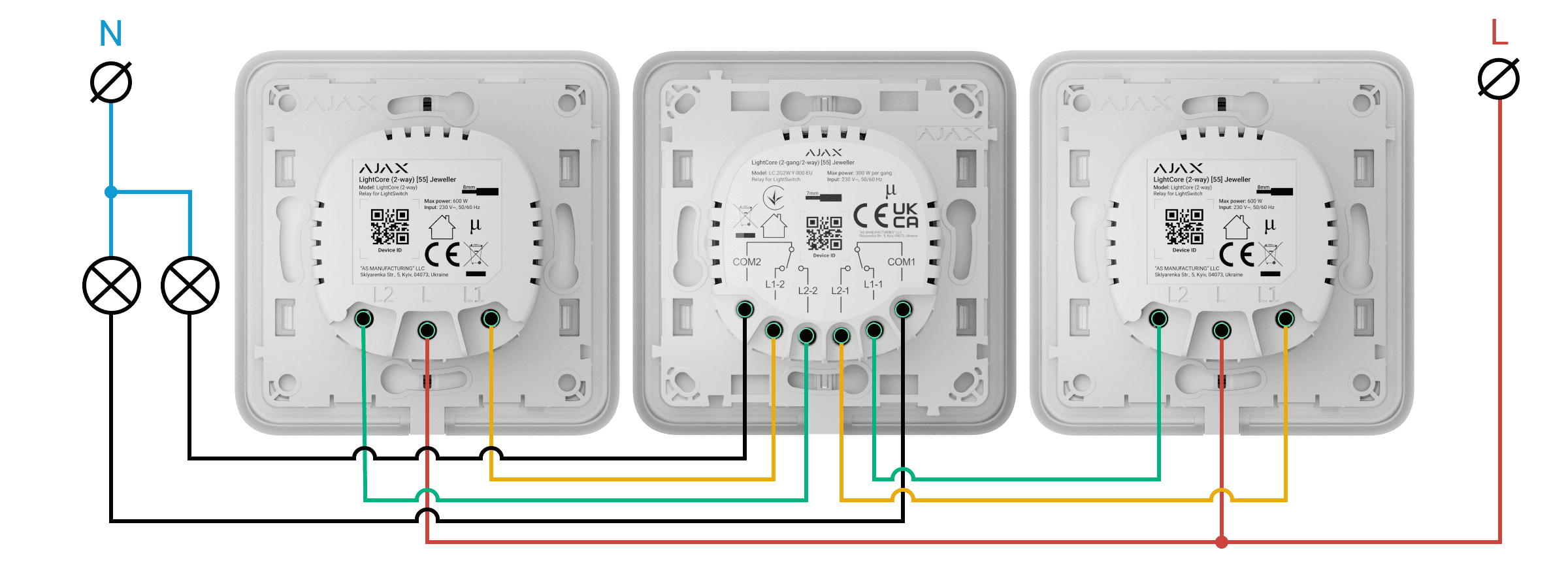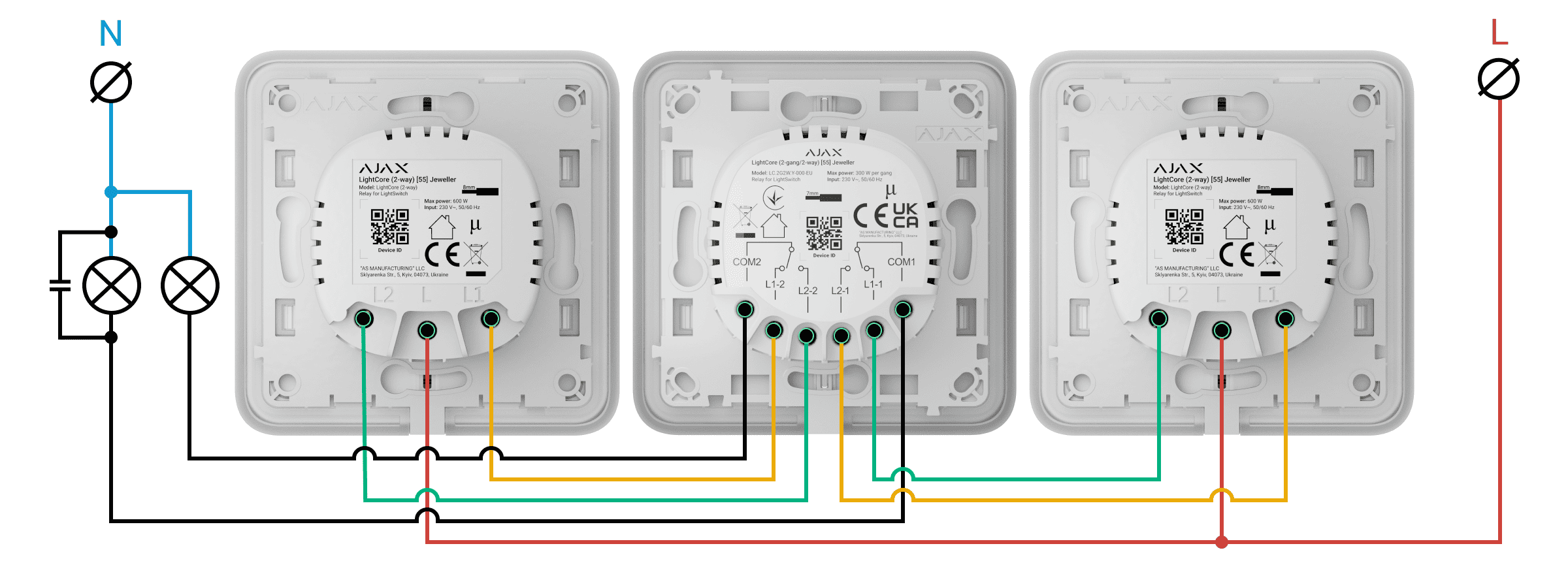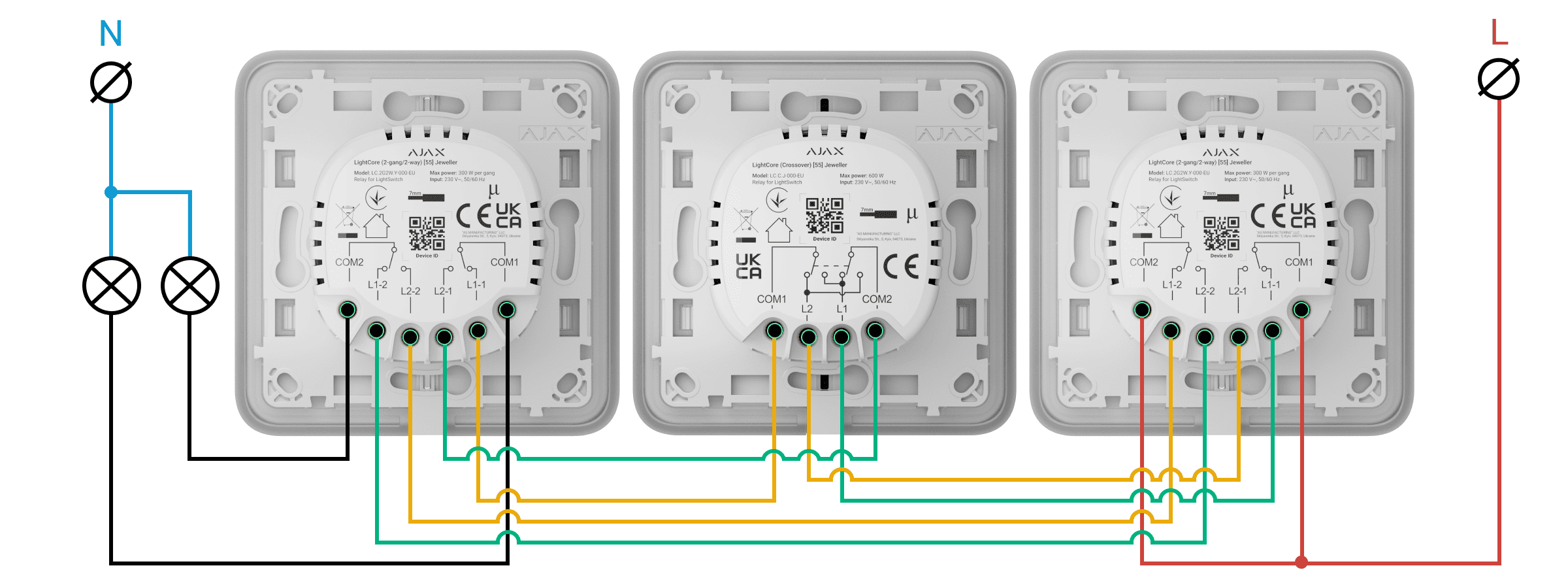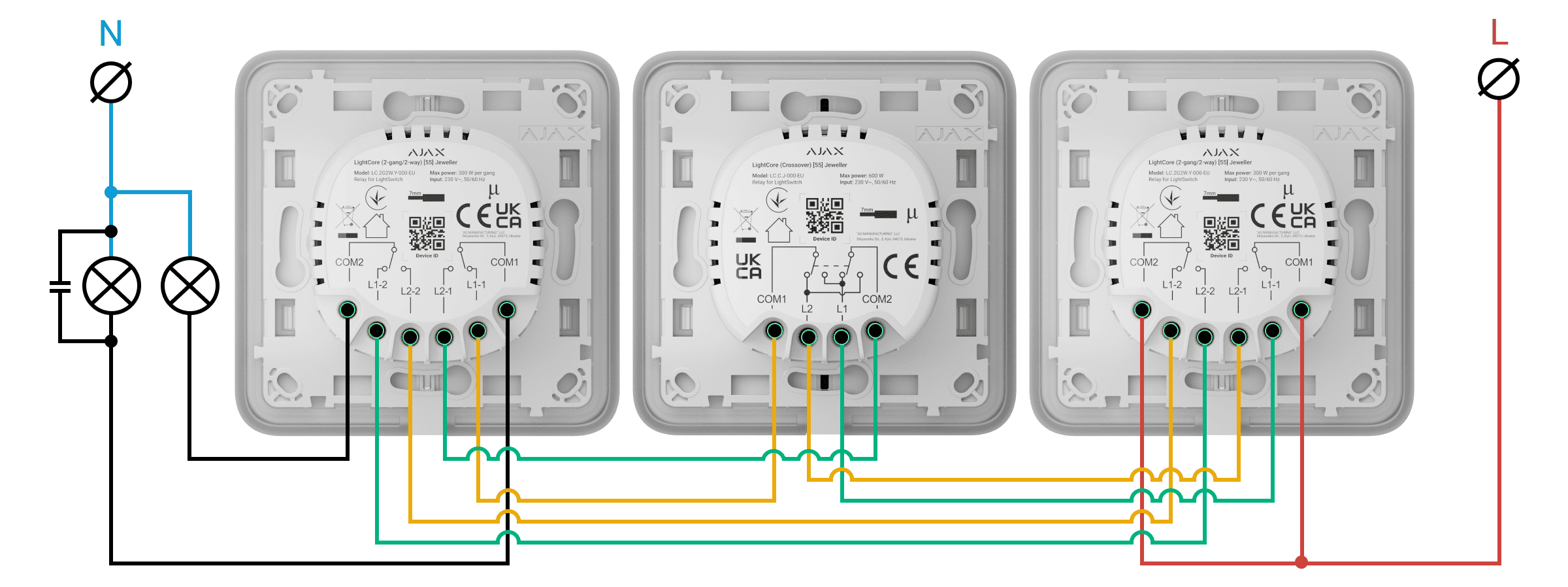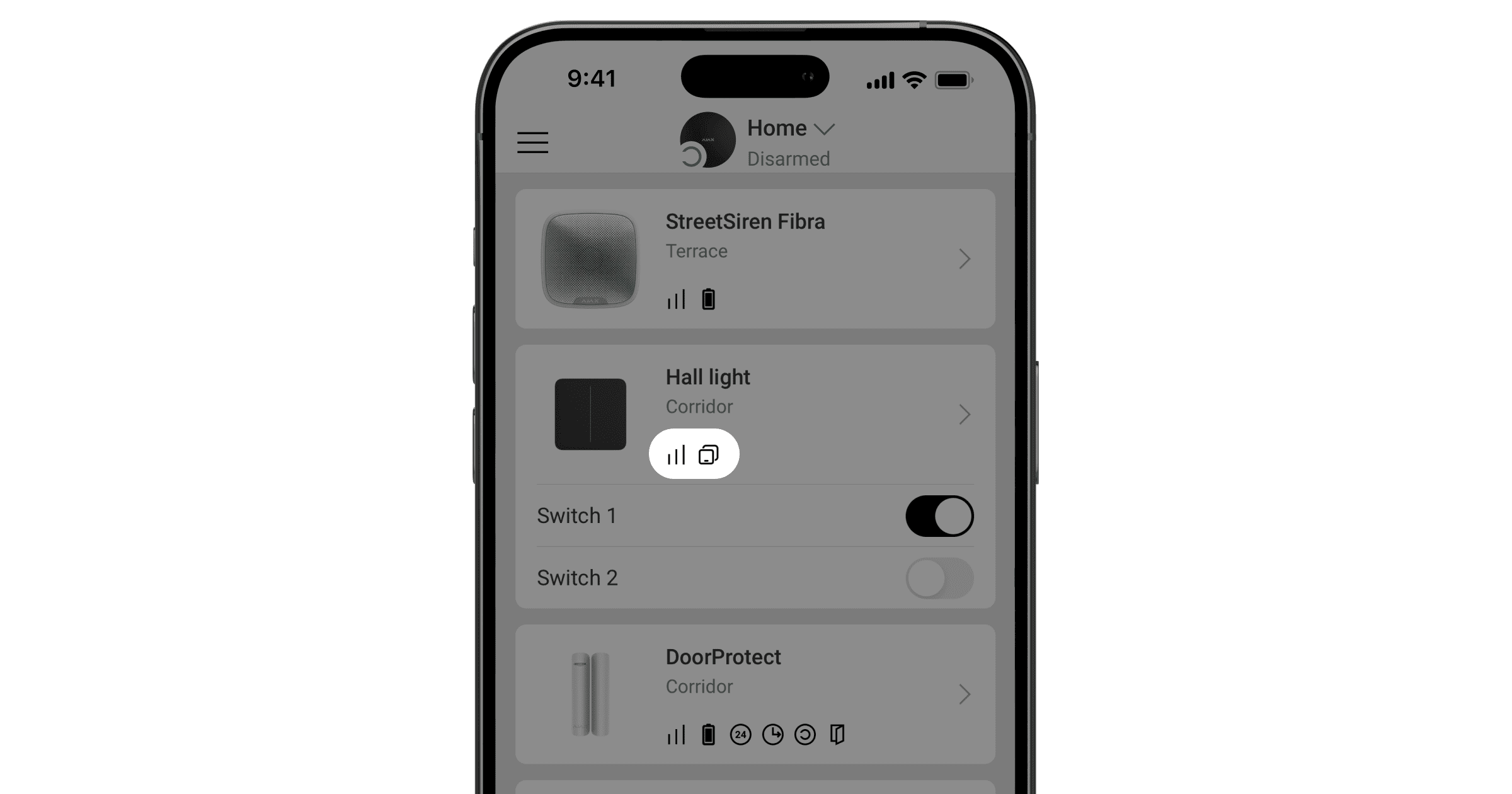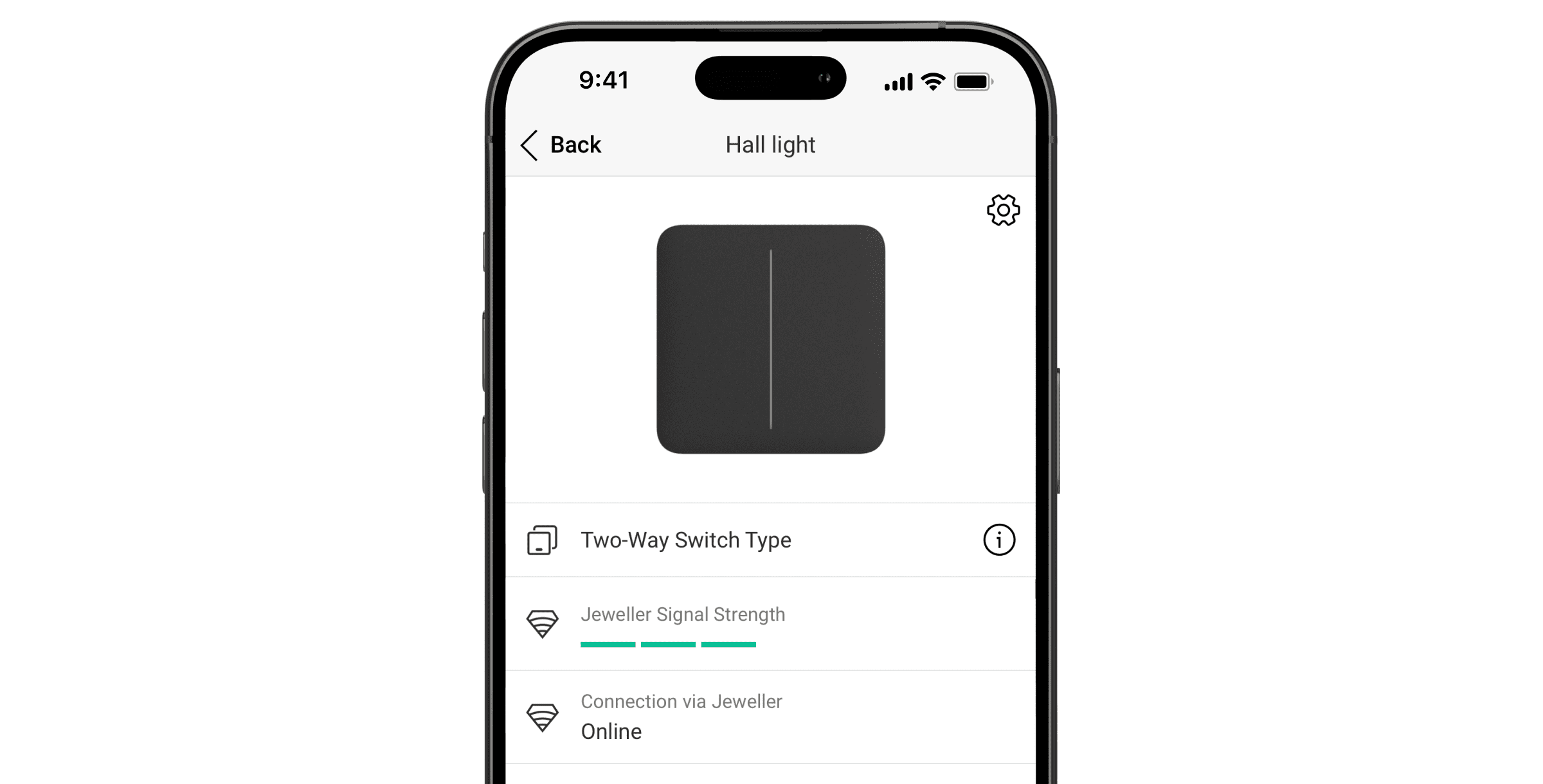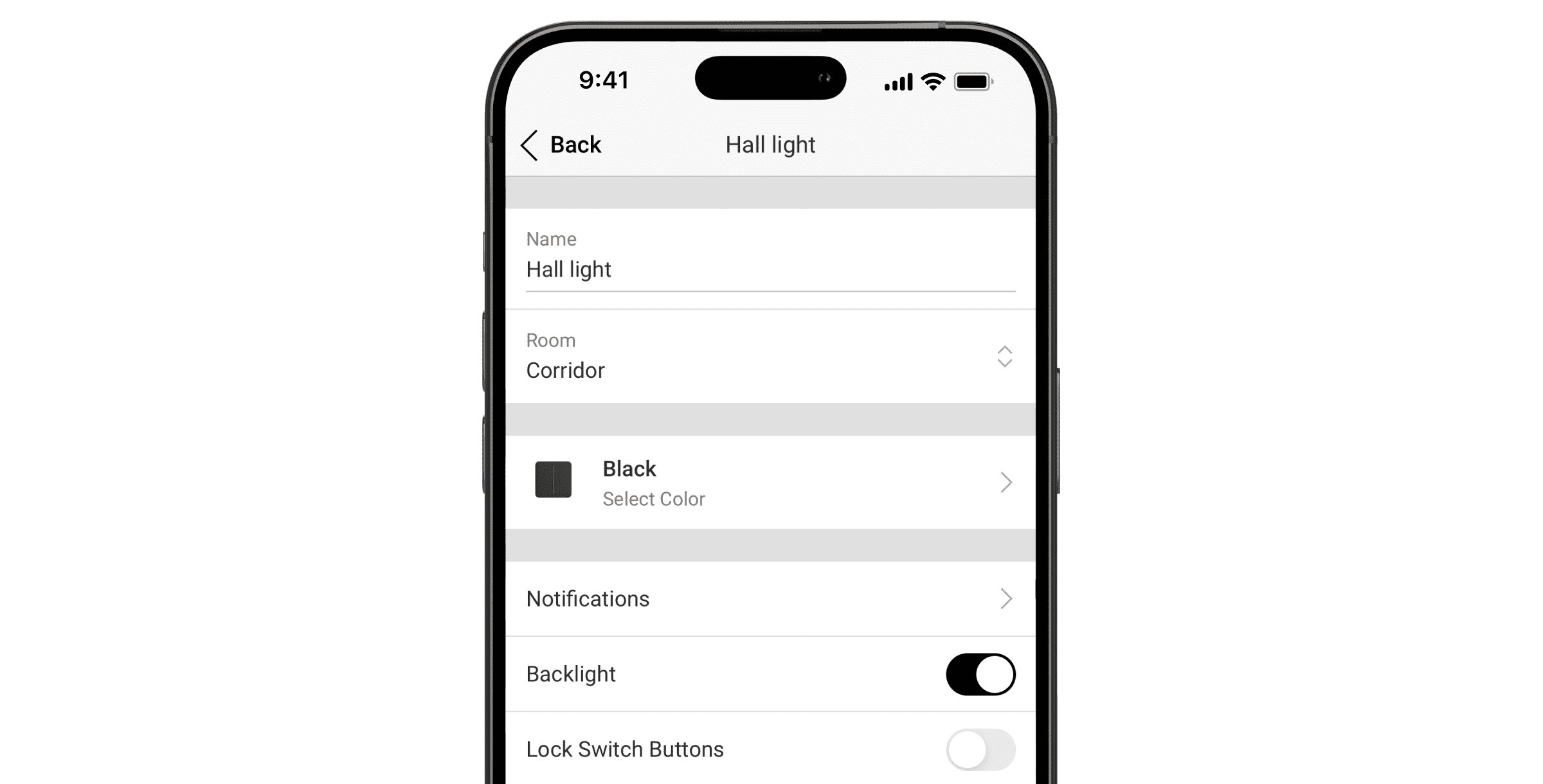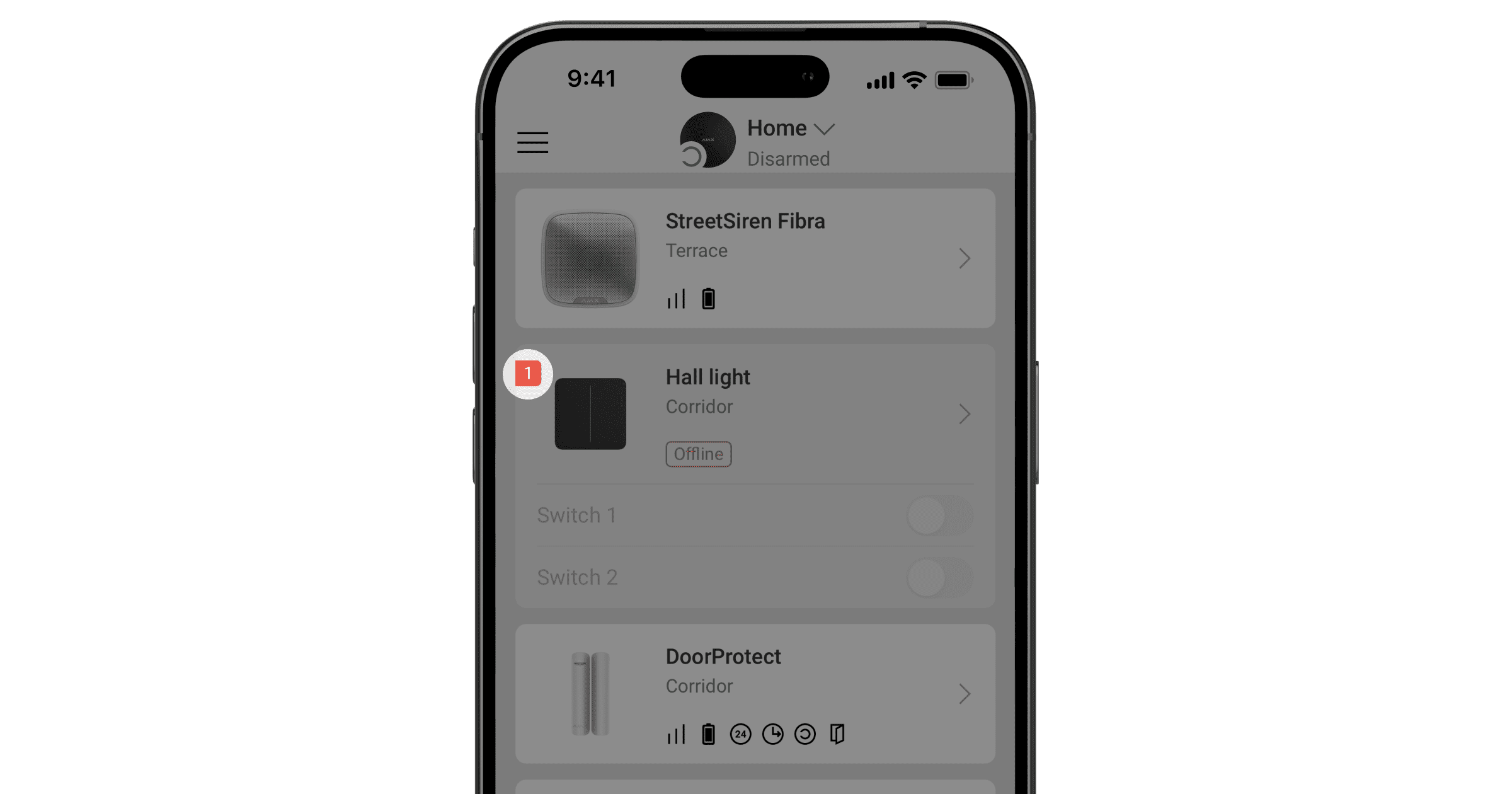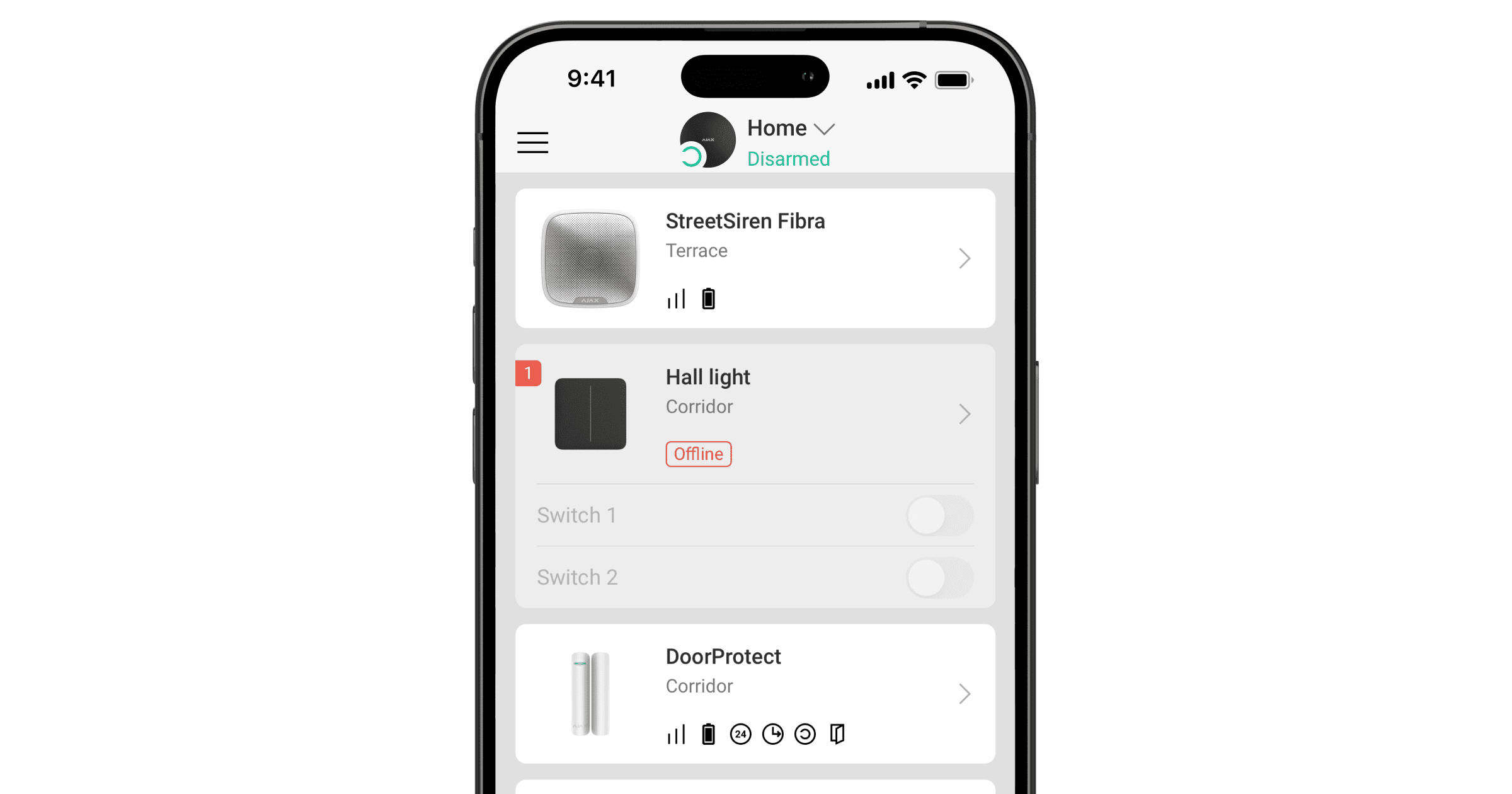LightSwitch Jeweller is a smart touch light switch for indoor installation. LightSwitch can replace any mechanical or touch switch: the product line includes one-gang and two-gang regular, two-way, and crossover versions. Devices can be combined as a set with Ajax smart switches and/or outlets* and installed horizontally or vertically into Frame side by side.
Use the online Ajax switches and outlets configurator to assemble your custom set. Combine devices into a frame, pick the color, and download your configuration as PDF.
LightSwitch is installed without changing the electrical wiring of the object. The device does not require a neutral wire and works only from the power phase. The switch features a standard European form factor (55).
LightSwitch operates as a part of the Ajax system and communicates with the hub using two secure protocols. The light switch uses Jeweller to transmit alarms and events, and Wings to update firmware. The communication range is up to 1,100 meters in an open space.
The list of compatible hubs and range extenders is available here.
* Combinations with smart outlets are available only in horizontal orientation.
Design
LightSwitch is a prefabricated smart light switch. All switch components are purchased separately. Elements are connected mechanically without the use of tools. There are two LightSwitch formats in the Ajax product line: single and combined. Combined switches can be horizontal and vertical.
Single switch

A single LightSwitch is a prefabricated device that consists of two components:
- LightCore (2-gang/2-way) — relay for a two-gang two-way switch.
- SoloButton (2-gang) — touch-sensitive panel for a two-gang switch.
Combined switch

A combined switch consists of several LightCore relays and touch-sensitive panels installed in one frame with the appropriate number of seats.
- LightCore (2-gang/2-way) — relay for a two-gang two-way switch.
- LightCore (2-gang/2-way) vertical — relay for a vertical two-gang two-way switch.
- Frame (2 seats) — frame for two devices.
- Frame (2 seats) vertical — vertical frame for two devices.
- Frame (3 seats) — frame for three devices.
- Frame (3 seats) vertical — vertical frame for three devices.
- Frame (4 seats) — frame for four devices.
- Frame (4 seats) vertical — vertical frame for four devices.
- Frame (5 seats) — frame for five devices.
- Frame (5 seats) vertical — vertical frame for five devices.
- CenterButton (2-gang) — central touch-sensitive panel for a two-gang switch.
- CenterButton (2-gang) vertical — central touch-sensitive panel for a vertical two-gang switch.
- SideButton (2-gang) — side touch-sensitive panel for a two-gang switch.
- SideButton (2-gang) vertical — side touch-sensitive panel for a vertical two-gang switch.
Side touch-sensitive panels are installed on the right and left or on the top and bottom sides of the frame, while central touch-sensitive panels are installed in the center. For example, two side panels and one central panel should be used for three switches in one frame.
Colors
The product line includes 8 colors of touch-sensitive panels: White, Fog, Grey, Graphite, Ivory, Oyster, Olive, and Black.
The RAL colors below are as close as an approximation of the actual color. However, they may slightly differ, so please only use them as a guide to the color choice.
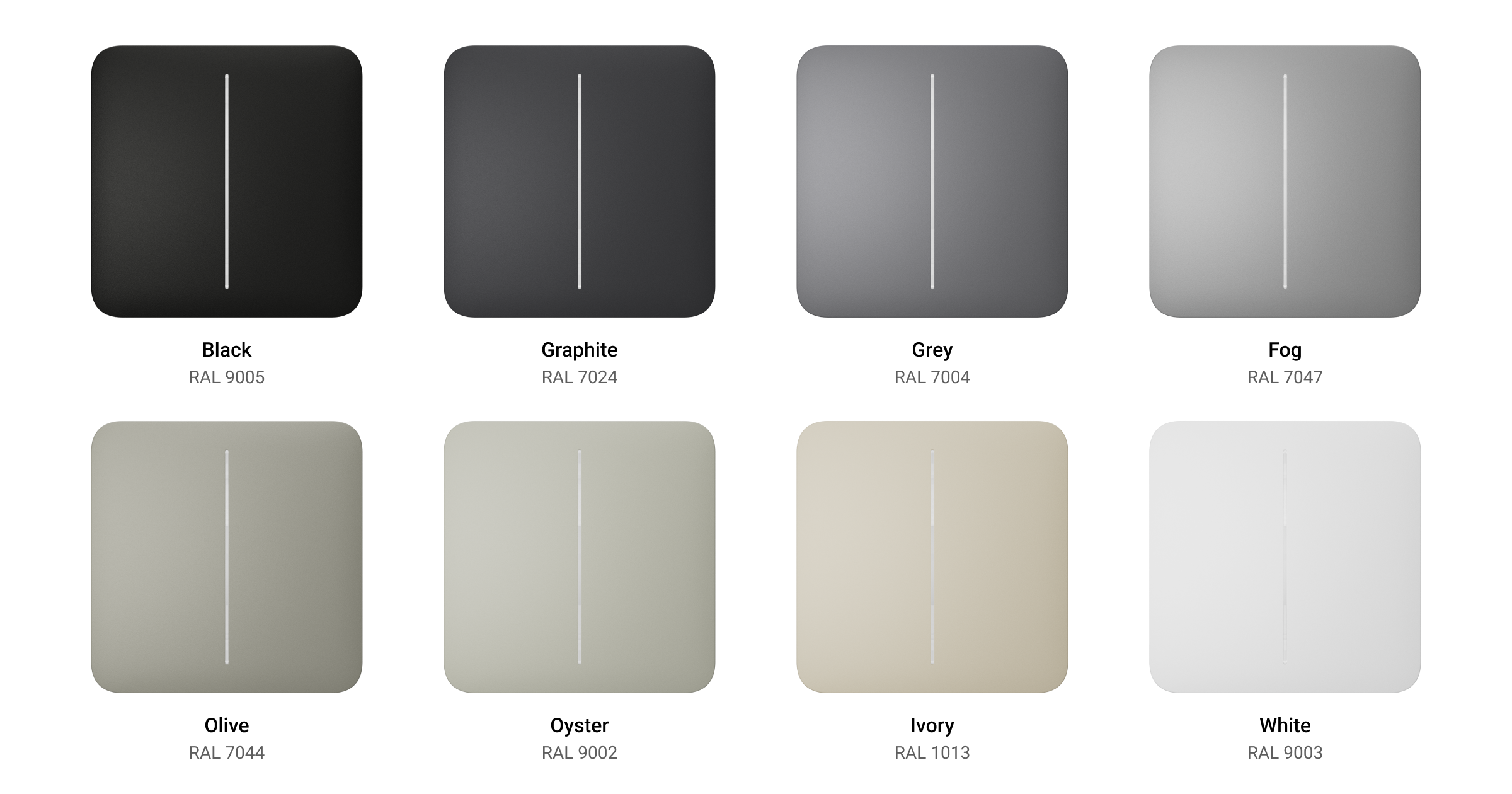
In the switch settings in Ajax apps, the color of LightSwitch can be selected. The color in the app does not necessarily have to match the color of the installed panel.
A PRO or user with admin rights can change the panel color anytime. For example, if an installer replaced the touch-sensitive panel or a user wants to set different colors for switches in the app to distinguish them.
Functional elements
Relay
- Device QR code and ID (serial number). It is used to add the switch to the Ajax system.
- Terminal of the first button for connecting the power phase wire or the power wire of the first lighting device or another load. For example, a hood.
- The first terminal of the first button for connection to another two-way switch.
- The second terminal of the first button for connection to another two-way switch.
- Terminal of the second button for connecting the power phase wire or the power wire of the second lighting device or another load. For example, a hood.
- The first terminal of the second button for connection to another two-way switch.
- The second terminal of the second button for connection to another two-way switch.
- Device QR code and ID (serial number). It is used to add the switch to the Ajax system.
- Terminal of the first button for connecting the power phase wire or the power wire of the first lighting device or another load. For example, a hood.
- The first terminal of the first button for connection to another two-way switch.
- The second terminal of the first button for connection to another two-way switch.
- Terminal of the second button for connecting the power phase wire or the power wire of the second lighting device or another load. For example, a hood.
- The first terminal of the second button for connection to another two-way switch.
- The second terminal of the second button for connection to another two-way switch.
Touch-sensitive panels
Ensure that the sticker shown in the image below has been removed from the touch-sensitive panel before installing it on LightCore. This is necessary for the correct LED indication of the device.


- The first button of the touch-sensitive panel.
- The second button of the touch-sensitive panel.

- The first button of the touch-sensitive panel.
- The second button of the touch-sensitive panel.

- The first button of the touch-sensitive panel.
- The second button of the touch-sensitive panel.

- The first button of the touch-sensitive panel.
- The second button of the touch-sensitive panel.

- The first button of the touch-sensitive panel.
- The second button of the touch-sensitive panel.
Frames
Frames are available with 2 to 5 seats in horizontal and vertical orientations. These frames are used when installing multiple LightSwitch and/or Outlet devices* in a row.
* Combinations with smart outlets are available only in horizontal orientation.

- Frame for two devices.
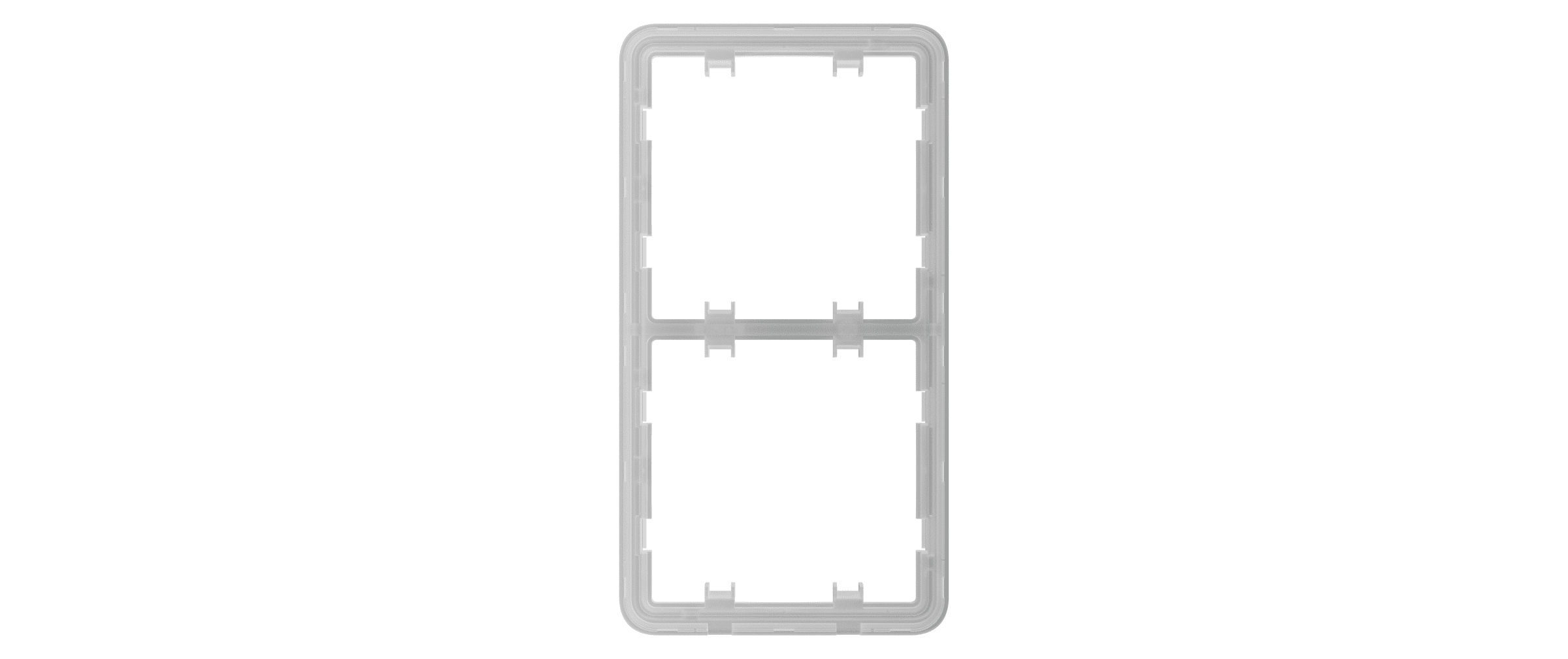
- Vertical frame for two devices.

- Frame for three devices.
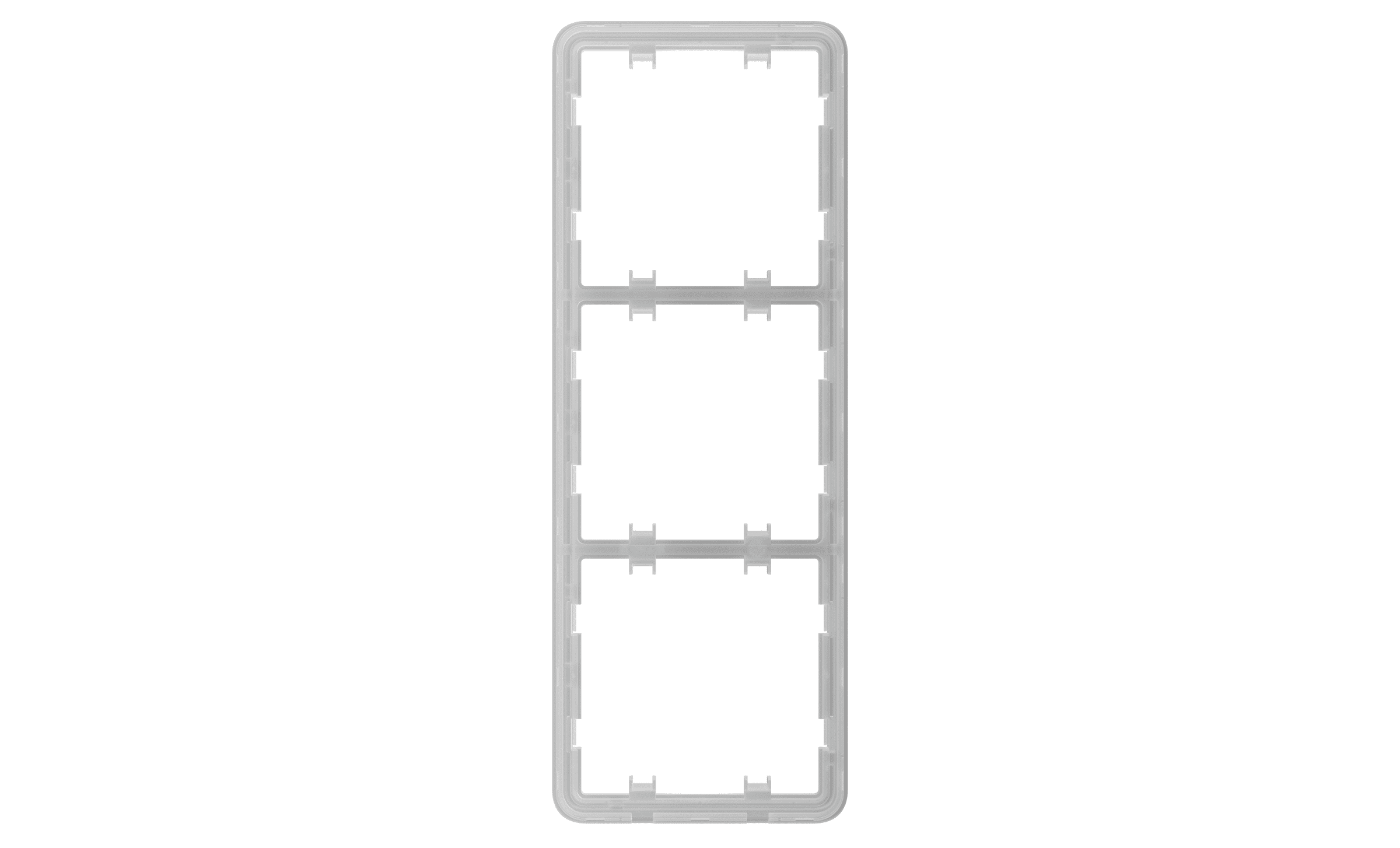
- Vertical frame for three devices.

- Frame for four devices.
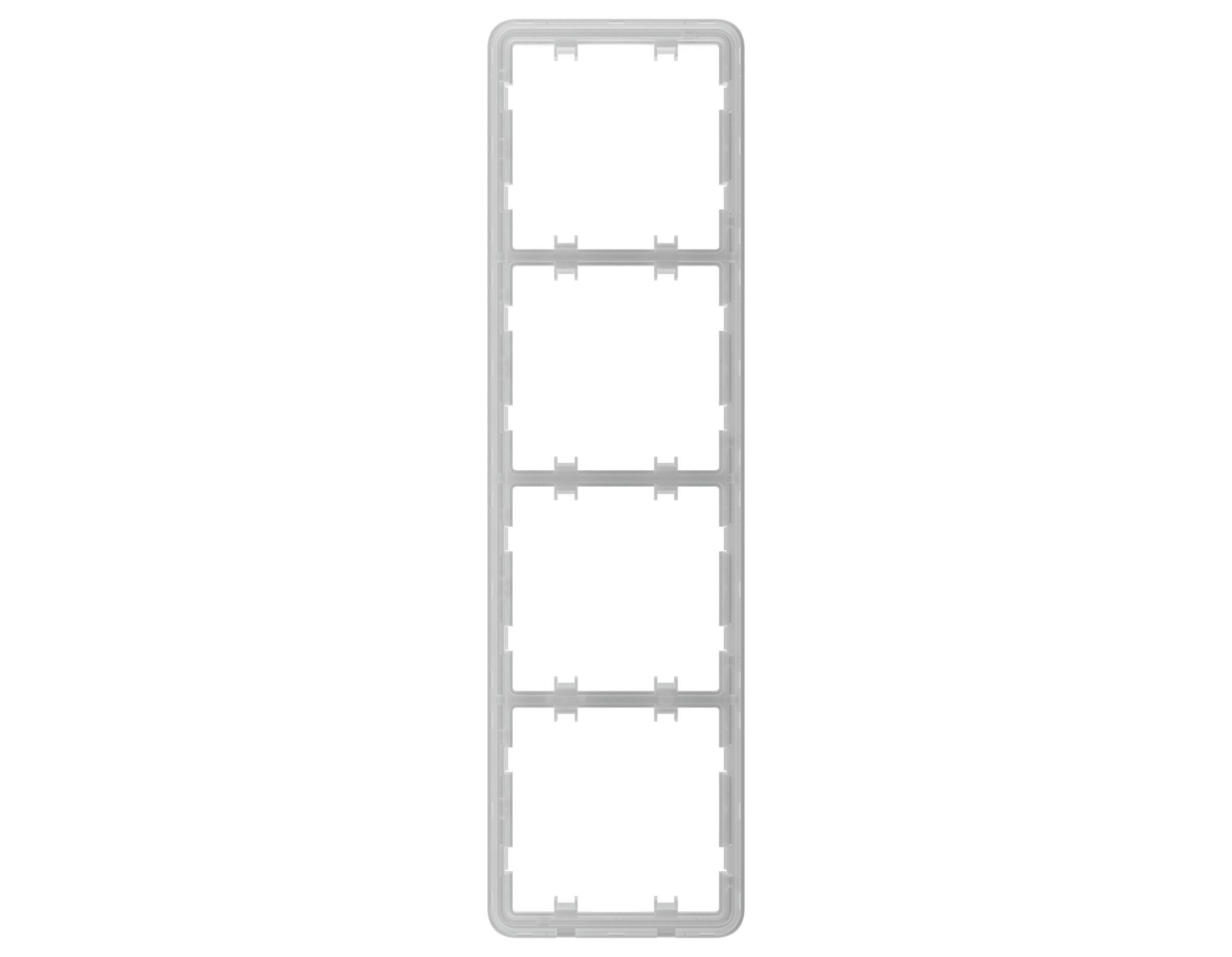
- Vertical frame for four devices.

- Frame for five devices.
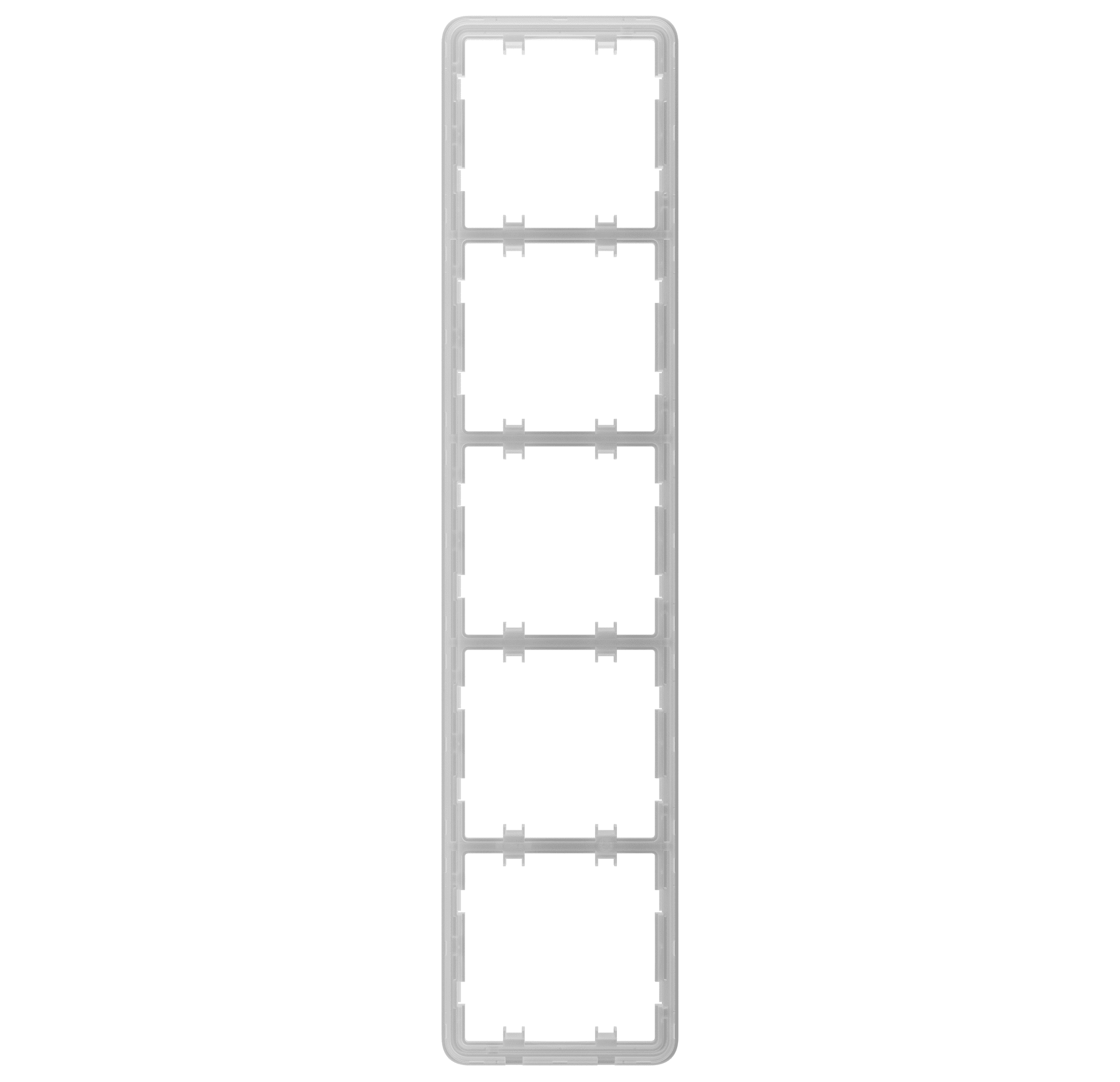
- Vertical frame for five devices.
Operating principle
LightSwitch is a smart touch light switch. It controls the lighting in three ways: manually, through smartphone and PC apps, and using automation scenarios.
LightSwitch is installed without changing the electrical wiring of the object. The device does not require a neutral wire and works only from the power phase.
LightSwitch can be used without adding to a hub. In this mode, it works like a regular touch switch.
LightSwitch can control 5 to 300 W lighting devices per one segment. The kit includes a capacitor connected in parallel with the lighting device for low-power lamps. See the installation section of this manual for details.
LightSwitch frame has an LED backlight. The backlight is not bright, so it will not disturb users even if the device is installed near a bed. If necessary, a PRO or user with admin rights can disable the backlight in Ajax apps.
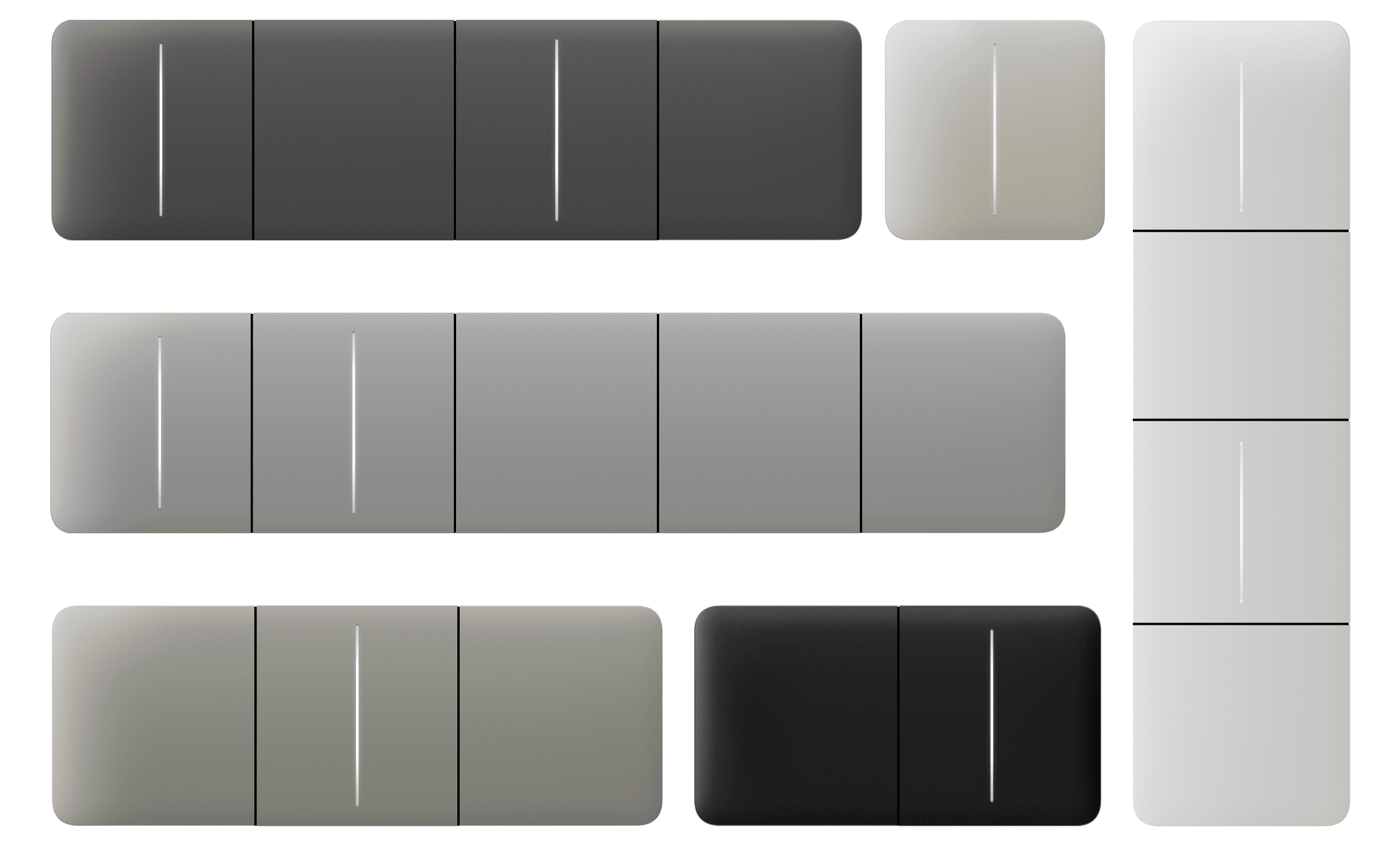
The product line of devices includes one-gang and two-gang regular, two-way, and crossover light switches:
- LightSwitch (1-gang) Jeweller
- LightSwitch (2-gang) Jeweller
- LightSwitch (2-way) Jeweller
- LightSwitch (2-gang/2-way) Jeweller
- LightSwitch (Crossover) Jeweller
Devices combined in a frame can be installed horizontally and vertically. Vertical installation is supported only by relays, touch-sensitive panels, and frames with the label “vertical” in the name.
Use the online Ajax switches and outlets configurator to assemble your custom set. Combine devices into a frame, pick the color, and download your configuration as PDF.
If necessary, LightSwitch can also control other appliances. For example, one button can control the light, and the other one — room ventilation.
Manual control
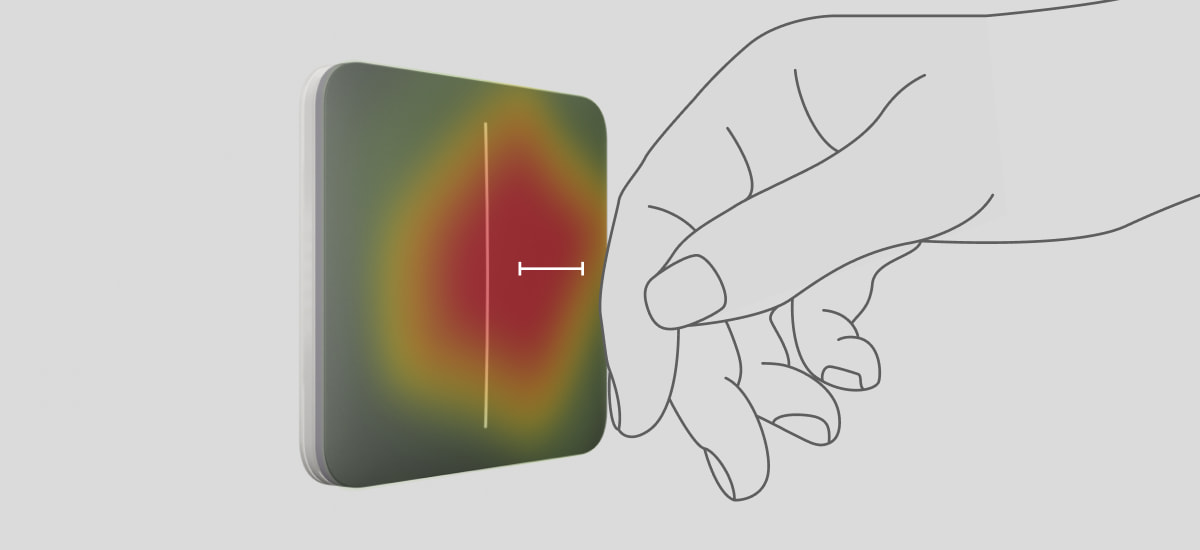
LightSwitch allows to control the lighting when a hand is 15 millimeters away from the switch or when touching the touch-sensitive panel of the switch. Contactless control does not limit the possibility of use, even if hands are dirty or wet. The sensor reacts under any conditions. Therefore, the switch can be installed in crowded places: restaurants, factories, and offices.
The sensitivity of the touch-sensitive panel can be adjusted in the device settings in the app. Higher sensitivity ensures contactless operation, while lower values might require slightly touching the switch button.
The LightSwitch sensor instantly reads the signal and transforms it into an electric pulse. LightCore receives this pulse and activates a relay that switches on/off the lighting device or another connected load, such as a cooker hood.
The entire LightSwitch panel is touch-sensitive. Therefore, the lighting can be controlled by touching or reaching any part of the touch-sensitive panel with a hand.
Remote control
Control via the app
LightSwitch can be used to control lighting manually and remotely through Ajax apps.
Сlick on the switch in the LightSwitch field in the Devices menu in the Ajax app, and the state of the switch contacts will change to the opposite. The lighting will be switched off/on. This way, system users can remotely control the lighting. For example, switch on the light in the room in advance before entering the room.
The lighting can also be controlled in the Control menu. To do this, go to the Control
menu and swipe up. All control devices added to the hub will appear in the list. Click on the switch in the LightSwitch field, and the state of the device contacts will change to the opposite. The lighting will be switched on/off.
Automation scenarios
Scenarios help automate security and reduce the number of routine actions. For example, set the lights to switch on by schedule or when disarming the security system.
LightSwitch supports the following types of scenarios:
- By alarm
- By arming/disarming
- By schedule
- By Button press
- By temperature
- By humidity
- By CO2 concentration
- By touching LightSwitch
Scenarios by humidity and CO2 concentration are available when LifeQuality is added to the system.
The system does not allow creating sequences of scenarios when the execution of one scenario activates the following one. This behavior is intended to prevent accidental endless looping of such scenarios.
Operation modes
LightSwitch can operate in one of two modes: bistable or pulse. The operating mode is set by a PRO or user with admin rights in Ajax apps in the device settings.
By default, LightSwitch operates in bistable mode. When controlling the lighting, it switches on/off.
When operating in pulse mode, the lighting can be switched on for the required time: from 10 seconds to 2 hours. This mode is useful, for example, if a user needs to switch on the lighting in the corridor for 5 minutes when disarming the security system.
Types of electrical protection of the switch

LightSwitch (2-gang/2-way) Jeweller has two independent types of protection: current and temperature.
Current protection is provided by the fast-blow 4 A fuse installed inside the device.
Temperature protection triggers if the switch temperature is greater than +60 °C. If this protection triggers, LightSwitch turns off the power and sends a notification to Ajax apps. The power supply is restored automatically when the switch temperature returns to normal.
Types of supported lamps
LightSwitch is compatible with most types of lamps and lighting devices. Detailed information on the LightSwitch operation with different types of lamps is described in the table.
| Type of lamp | Compatibility | Supported power | Maximum current | Comments |
LED lamp / LED Corn lamp / LED panel / LED strip, etc.
    |
Yes | up to 300 W per segment (up to 600 W in total) |
2.6 А | |
Incandescent
 |
Yes | up to 300 W per segment (up to 600 W in total) |
2.6 А | |
Halogen
 |
Yes | up to 300 W per segment (up to 600 W in total) |
2.6 А | |
Fluorescent (conventional)
  |
Yes | up to 300 W per segment (up to 600 W in total) |
2.6 А | |
Fluorescent (compact)
  |
Not recommended | up to 240 W per segment (up to 480 W in total) |
2.6 А | Rare flashing is possible. |
| Smart lamps of any type | No | – | – |
Lamps with built-in brightness and color controllers, relays, radio modules, and microcontrollers. Stable operation can not be guaranteed. |
| Mixed light | No | – | – | Designed for non-home / non-office use. |
| Mercury-vapor | No | – | – | Designed for non-home / non-office use. |
| Metal-halide | No | – | – | Designed for non-home / non-office use. |
| Sodium-vapor | No | – | – | Designed for non-home / non-office use. |
Detection of lighting devices with insufficient power
LightSwitch continuously checks its power supply parameters. If LightSwitch controls the power of a lighting device with insufficient power (up to 5 W), the system will notify users. In this case, it is necessary to replace the lighting device with a similar one with higher capacity or to connect a bundled capacitor in parallel with the lighting device.
Jeweller and Wings data transfer protocols
Jeweller and Wings are wireless data transfer protocols that provide two-way fast and reliable communication between the hub and devices. The light switch uses Jeweller to transmit alarms and events, and Wings to update the firmware.
Firmware update
If a new firmware version for LightSwitch is available, the icon appears in Ajax apps in the Devices
tab. You can launch the update in states or via the light switch settings. Follow the on-screen instructions to successfully update the firmware.
Information on firmware updates and new versions is available only for light switches that use the ReX 2 radio signal range extender and/or are added to such control panels:
Users will receive information about the new firmware version if the light switch is connected to the hub via ReX. However, the update is possible only after adding the light switch directly to the above control panels.
Firmware updates are not available for LightSwitch when operating via Hub Plus.
Sending events to the monitoring station
The Ajax system can transmit alarms to both PRO Desktop monitoring app and the central monitoring station (CMS) in the formats of SurGard (Contact ID), SIA (DC-09), ADEMCO 685, and other protocols.
Only events of lost connection between the switch and the hub (or range extender) are transmitted to the CMS. No other events are sent to third-party monitoring stations of security or monitoring companies. Use PRO Desktop to receive all switch events on the CMS.
Temperature protection triggering events are not sent to PRO Desktop as alarms.
When an alarm is received, the operator at the security company’s CMS knows what happened and precisely where to dispatch a rapid response team. The addressability of Ajax devices allows sending events to PRO Desktop or the CMS, including the device type, its name, security group, and virtual room. Note that the list of transmitted parameters may vary depending on the CMS type and the selected communication protocol for it.
The ID and number of the device can be found in its states in the Ajax app.
Selecting the installation site
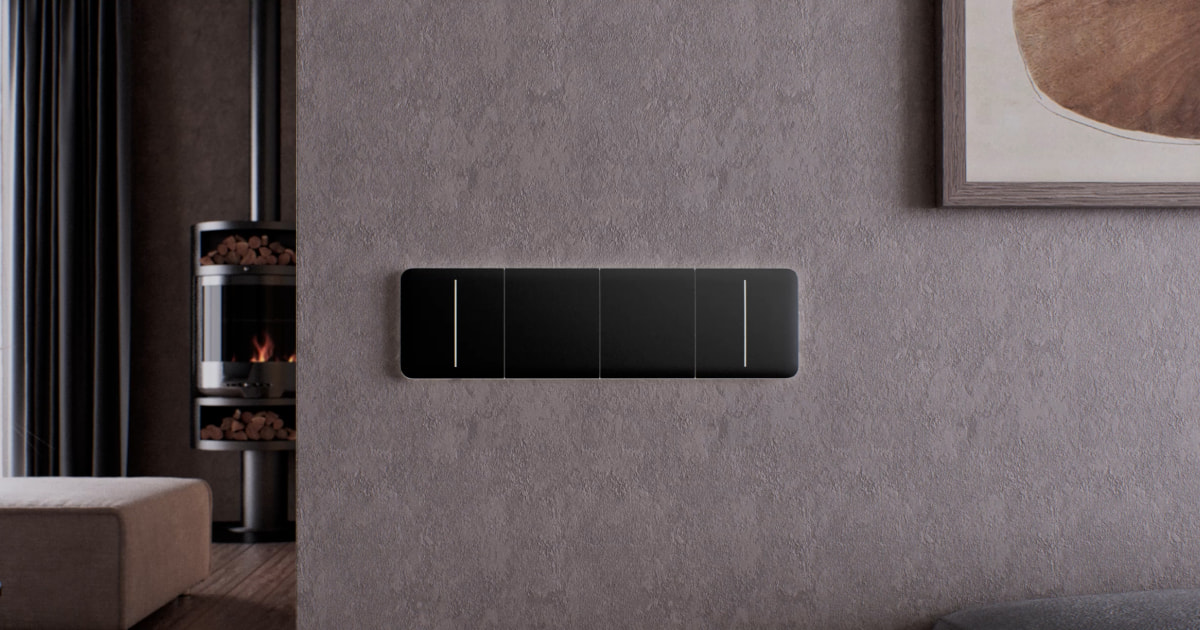
LightSwitch is designed to fit into standard sub-sockets of the European form factor (55). The device should be connected to the power phase wire for proper operation. Connection of the neutral wire is not required.
Do not connect the neutral wire to the LightSwitch terminals. This can damage the device.
Signal strength
The Jeweller and Wings signal strength is determined by the number of undelivered or corrupted data packages over a certain period of time. The icon on the Devices
tab indicates the signal strength:
- three bars — excellent signal strength;
- two bars — good signal strength;
- one bar — low signal strength, stable operation is not guaranteed;
- crossed out icon — no signal.
Check the Jeweller and Wings signal strength before the final installation. With a signal strength of one or zero bars, we do not guarantee stable operation of the device. Consider relocating the device, as adjusting its position even by 20 cm can significantly improve the signal strength. If the signal remains poor or unstable after relocation, consider using ReX or ReX 2 radio signal range extender.
Do not install the switch
- Outdoors. The device has an IP20 protection class. This may result in device failure or incorrect operation.
- On metal structures. This can lead to incorrect operation of the sensor: it may not respond to touch or give false triggerings.
- In rooms with humidity and temperature that are outside the permissible limits. This may cause a malfunction or incorrect operation of the device. The operating temperature range is from –10 to +40 °C. The permissible humidity is up to 75% without condensation.
- In places with low or unstable signal strength. This may result in a loss of communication between the hub (or range extender) and the switch.
Installation
Only a qualified electrician or installer should install LightSwitch. Do not switch on the power at the switches before installing the touch-sensitive panels. Also, do not try to register the device before installing the touch-sensitive panel, as it contains antennas needed to communicate with the hub.
Before installing the switch, ensure that the optimal location has been selected and that it complies with the requirements of this manual. When installing and operating the device, follow the general electrical safety rules for using electrical appliances and the requirements of electrical safety regulations.
For connection, use cables with a cross-section recommended by the manufacturer of the lighting device. LightSwitch (2-gang/2-way) Jeweller cannot be connected to electric circuits with a load exceeding 300 W per switch segment. The device does not require a neutral wire and works only from the supply phase.
After installing and connecting the switch, be sure to run the Jeweller Signal Strength Test and and Wings Signal Strength Test, and check the operation of the device: how it responds to touch, and whether it switches on/off the lights.
The installed touch-sensitive panel can be removed from LightSwitch with a flat screwdriver. To complete this, insert it into the hole from below (or from the left for vertical switches) and turn the screwdriver.
Ensure that the sticker shown in the image below has been removed from the touch-sensitive panel before installing it on LightCore. This is necessary for the correct LED indication of the device.

Two LightSwitch (2-gang/2-way) Jeweller
- De-energize the power cables to which the LightCore relays will be connected.
- Prepare the mounting boxes and remove the pre-installed switches, if any.
- Connect the wires to the LightCore relays according to the diagram below:
- Connect the power phase wires to the first LightCore relay (terminals COM1 and COM2).
- Connect the power wire of the first lighting device to Channel 1 of the second LightCore relay (terminal COM1).
- Connect the power wire of the second lighting device to Channel 2 of the second LightCore relay (terminal COM2).
- Connect Channel 1 of the first LightCore relay (terminals L1-1 and L2-1) to Channel 1 of the second LightCore relay (terminals L1-1 and L2-1).
- Connect Channel 2 of the first LightCore relay (terminals L1-2 and L2-2) to Channel 2 of the second LightCore relay (terminals L1-2 and L2-2).
- Connect a bundled capacitor in parallel with the lighting appliance connected to Channel 1 of the LightCore relays if:
- its power is less than 5 W (an approximate value that can vary depending on the type and technical characteristics of the lighting appliance);
- it flashes in a turned-off state;
- LightSwitch is malfunctioning or unstable;
- adding LightSwitch to the system fails (with an installed touch-sensitive panel);
- another abnormal operation of LightSwitch or lighting appliance is observed.
Do not connect the neutral wire to the LightSwitch terminals. LightSwitch operates only from the power phase.
- Install the LightCore relay in the mounting box.
- Secure the LightCore relay with the bundled fasteners.
- Install the remaining LightCore relays if necessary.
- If installing multiple LightSwitch or Outlet devices*, mount the frame with the appropriate number of seats.
- Install the necessary touch-sensitive panels.
- Switch on the power.
- Add switches to the hub using the Ajax app.
* Combinations with smart outlets are available only in horizontal orientation.
LightSwitch (2-gang/2-way) Jeweller and a third-party two-gang two-way switch
- De-energize the power cables to which the LightCore relay and a third-party switch will be connected.
- Prepare the mounting boxes and remove the pre-installed switches, if any.
- Connect the wires to the LightCore relay and a third-party switch according to the diagram below:
- Connect the power phase wires to the third-party switch according to the manufacturer’s diagram.
- Connect the power wire of the first lighting device to Channel 1 of the second LightCore relay (terminal COM1).
- Connect the power wire of the second lighting device to Channel 2 of the second LightCore relay (terminal COM2).
- Connect Channel 1 of the LightCore relay (terminals L1-1 and L2-1) to the first channel of a third-party switch according to the manufacturer’s diagram.
- Connect Channel 2 of the LightCore relay (terminals L1-2 and L2-2) to the second channel of a third-party switch according to the manufacturer’s diagram.
- Connect a bundled capacitor in parallel with the lighting appliance connected to Channel 1 of the LightCore relay if:
- its power is less than 5 W (an approximate value that can vary depending on the type and technical characteristics of the lighting appliance);
- it flashes in a turned-off state;
- LightSwitch is malfunctioning or unstable;
- adding LightSwitch to the system fails (with an installed touch-sensitive panel);
- another abnormal operation of LightSwitch or lighting appliance is observed.
Do not connect the neutral wire to the LightSwitch terminals. LightSwitch operates only from the power phase.
- Install the LightCore relay in the mounting box.
- Secure the LightCore relay with the bundled fasteners.
- Install the remaining LightCore relays if necessary.
- If installing multiple LightSwitch or Outlet devices*, mount the frame with the appropriate number of seats.
- Install the necessary touch-sensitive panels.
- Switch on the power.
- Add switches to the hub using the Ajax app.
* Combinations with smart outlets are available only in horizontal orientation.
LightSwitch (2-gang/2-way) Jeweller as a regular two-gang switch
- De-energize the power cable to which the LightCore relay will be connected.
- Prepare the mounting box and remove the pre-installed switch, if any.
- Connect the wires to the LightCore relay according to the diagram below:
- Connect the power phase wires to the first LightCore relay (terminals COM1 and COM2).
- Connect the power wire of the first lighting device to Channel 1 of the LightCore relay (terminal L1-1 or L2-1).
- Connect the power wire of the second lighting device to Channel 2 of the LightCore relay (terminal L1-2 or L2-2).
- Connect a bundled capacitor in parallel with the lighting appliance connected to Channel 1 of the LightCore relay if:
- its power is less than 5 W (an approximate value that can vary depending on the type and technical characteristics of the lighting appliance);
- it flashes in a turned-off state;
- LightSwitch is malfunctioning or unstable;
- adding LightSwitch to the system fails (with an installed touch-sensitive panel);
- another abnormal operation of LightSwitch or lighting appliance is observed.
Do not connect the neutral wire to the LightSwitch terminals. LightSwitch operates only from the power phase.
- Install the LightCore relay in the mounting box.
- Secure the LightCore relay with the bundled fasteners.
- Install the remaining LightCore relays if necessary.
- If installing multiple LightSwitch or Outlet devices*, mount the frame with the appropriate number of seats.
- Install the necessary touch-sensitive panels.
- Switch on the power.
- Add switches to the hub using the Ajax app.
* Combinations with smart outlets are available only in horizontal orientation.
LightSwitch (2-gang/2-way) Jeweller and two LightSwitch (2-way) Jeweller
- De-energize the power cables to which the LightCore relays will be connected.
- Prepare the mounting boxes and remove the pre-installed switches, if any.
- Connect the wires to the LightCore relays according to the diagram below:
- Connect the power phase wires to the two-way LightCore (2-way) relays (terminals L).
- Connect the power wire of the first lighting device to Channel 1 of the LightCore (2-gang/2-way) relay (terminal COM1).
- Connect the power wire of the second lighting device to Channel 2 of the LightCore (2-gang/2-way) relay (terminal COM2).
- Connect Channel 1 of the LightCore (2-gang/2-way) relay (terminals L1-1 and L2-1) to the first LightCore (2-way) relay (terminals L1 and L2).
- Connect Channel 2 of the LightCore (2-gang/2-way) relay (terminals L1-2 and L2-2) to the second LightCore (2-way) relay (terminals L1 and L2).
- Connect a bundled capacitor in parallel with the lighting appliance connected to Channel 1 of the LightCore (2-gang/2-way) relay if:
- its power is less than 5 W (an approximate value that can vary depending on the type and technical characteristics of the lighting appliance);
- it flashes in a turned-off state;
- LightSwitch is malfunctioning or unstable;
- adding LightSwitch to the system fails (with an installed touch-sensitive panel);
- another abnormal operation of LightSwitch or lighting appliance is observed.
Do not connect the neutral wire to the LightSwitch terminals. LightSwitch operates only from the power phase.
- Install the LightCore relay in the mounting box.
- Secure the LightCore relay with the bundled fasteners.
- Install the remaining LightCore relays if necessary.
- If installing multiple LightSwitch or Outlet devices*, mount the frame with the appropriate number of seats.
- Install the necessary touch-sensitive panels.
- Switch on the power.
- Add switches to the hub using the Ajax app.
* Combinations with smart outlets are available only in horizontal orientation.
Two LightSwitch (2-gang/2-way) Jeweller and LightSwitch (Crossover) Jeweller — two lighting devices
- De-energize the power cables to which the LightCore relays will be connected.
- Prepare the mounting boxes and remove the pre-installed switches, if any.
- Connect the wires to the LightCore relays according to the diagram below:
- Connect the power phase wires to the first LightCore (2-gang/2-way) relay (terminals COM1 and COM2).
- Connect the power wire of the first lighting device to Channel 1 of the second LightCore (2-gang/2-way) relay (terminal COM1).
- Connect the power wire of the second lighting device to Channel 2 of the second LightCore (2-gang/2-way) relay (terminal COM2).
- Connect Channel 1 of the first LightCore (2-gang/2-way) relay (terminals L1-1 and L2-1) to the LightCore (Crossover) relay (terminals L1 and L2).
- Connect Channel 1 of the second LightCore (2-gang/2-way) relay (terminals L1-1 and L2-1) to the LightCore (Crossover) relay (terminals COM1 and COM2).
- Connect Channel 2 of the first LightCore (2-gang/2-way) relay (terminals L1-2 and L2-2) to Channel 2 of the second LightCore (2-gang/2-way) relay (terminals L1-2 and L2-2).
- Connect a bundled capacitor in parallel with the lighting appliance connected to Channel 1 of the LightCore (2-gang/2-way) relays if:
- its power is less than 9 W (an approximate value that can vary depending on the type and technical characteristics of the lighting appliance);
- it flashes in a turned-off state;
- LightSwitch is malfunctioning or unstable;
- adding LightSwitch to the system fails (with an installed touch-sensitive panel);
- another abnormal operation of LightSwitch or lighting appliance is observed.
Do not connect the neutral wire to the LightSwitch terminals. LightSwitch operates only from the power phase.
- Install the LightCore relay in the mounting box.
- Secure the LightCore relay with the bundled fasteners.
- Install the remaining LightCore relays if necessary.
- If installing multiple LightSwitch or Outlet devices*, mount the frame with the appropriate number of seats.
- Install the necessary touch-sensitive panels.
- Switch on the power.
- Add switches to the hub using the Ajax app.
* Combinations with smart outlets are available only in horizontal orientation.
Adding to the system
Before adding a device
- Install the Ajax app.
- Log in to your account or create a new one.
- Select a space or create a new one.
The space functionality is available for apps of such versions or later:
- Ajax Security System 3.0 for iOS;
- Ajax Security System 3.0 for Android;
- Ajax PRO: Tool for Engineers 2.0 for iOS;
- Ajax PRO: Tool for Engineers 2.0 for Android;
- Ajax PRO Desktop 4.0 for macOS;
- Ajax PRO Desktop 4.0 for Windows.
- Add at least one virtual room.
- Add a compatible hub to the space. Ensure the hub is switched on and has internet access via Ethernet, Wi-Fi, and/or mobile network.
- Ensure the space is disarmed, and the hub is not starting an update by checking statuses in the Ajax app.
Only a PRO or a space admin with the rights to configure the system can add a device to the hub.
Pairing with the hub
Do not switch on the power at the switches before installing the touch-sensitive panels. Also, do not try to register the device before installing the touch-sensitive panel, as it contains antennas necessary for communication with the hub.
LightSwitch should be within the coverage area of the hub’s radio network to pair with the hub. To work via the radio signal range extender, pair LightSwitch with the hub and then add it to the range extender. This can be done in the range extender settings. Detailed instructions can be found in the manual for the relevant range extender.
The hub and the switch operating at different frequencies are incompatible. The radio frequency range of the device may vary by region. We recommend buying and using Ajax devices in the same region. Please contact Technical Support for information on the operating frequency range.
LightSwitch only works with one hub. When paired with a new hub, the switch stops sending commands to the old one. When added to a new hub, the switch is not removed from the device list of the old hub. This must be done through the Ajax app.
To add LightSwitch to the hub:
- Install LightSwitch if you haven’t done so before.
- Open the Ajax app and select the hub where you want to add the device.
- Go to the Devices
tab and click Add device.
- Enter the name of the device.
- Scan the QR code of the device or enter the ID manually. QR code is located on the rear panel of LightCore, the front panel of LightCore, and the device packaging. The device ID can be found below the QR code.
- Select a room and a group (if the group mode is enabled).
- Click Add.
If the maximum number of devices is added to the hub, you will get a notification about exceeding the device limit when you try to add the switch in the Ajax app. The number of devices that can be added to the hub depends on the control panel model and the Jeweller (or Jeweller/Fibra) settings.
- In a few seconds, LightSwitch will appear in the list of hub devices. Updating the device states in the list depends on the Jeweller (or Jeweller/Fibra) settings. The default value is 36 seconds.
If the connection fails, try again in 5 seconds. But this time, during the countdown, press and hold either switch button for at least 3 seconds.
If you press and hold the button of LightSwitch not paired with the hub for at least 3 seconds, the switch flashes green every second for one minute to inform you that it is not paired with the hub.
Functionality testing
After installation, test the operation of the switch: how it responds to touch and whether it switches on/off the light.
The Ajax system provides several tests to select the location of devices correctly. Tests do not start immediately. However, the waiting time does not exceed the duration of one “hub — device” ping interval. The default value is 36 seconds. The device ping interval can be changed in the Jeweller (or Jeweller/Fibra) menu in the hub settings.
The Jeweller Signal Strength Test Wings Signal Strength Test are available for LightSwitch. The test allows determining the strength and stability of the signal at the installation site.
To run a test in the Ajax app:
- Select the required hub.
- Go to the Devices
tab.
- Select LightSwitch from the list.
- Go to Settings
.
- Select a test:
- Run and perform the test using the prompts in the app.
Icons
Icons display some of LightSwitch states. Icons can be checked in the Ajax app in the Devices tab.
| Icon | Meaning |
|
Jeweller Signal Strength displays the signal strength between the hub and the switch. |
|
| The switch communicates with the hub via a radio signal range extender. | |
|
Temperature protection was activated. |
|
| The device has lost connection with the hub or the hub has lost connection with the Ajax Cloud server. | |
|
The device has not been transferred to the new hub. |
States
The states include information about the switch and its operating parameters. LightSwitch states can be seen in the Ajax app. To see them:
- Open the Ajax app.
- Select the required hub.
- Go to the Devices
tab.
- Select LightSwitch in the list.
| Parameter | Meaning |
| Data import | Displays the error when transferring data to the new hub:
|
| Malfunction |
Clicking on The field is displayed only if a malfunction is detected. |
| New firmware version available |
Clicking on The field is displayed if a new firmware version is available, and the light switch has been connected to any compatible control panel except Hub Plus. |
| Jeweller signal strength |
Signal strength between the switch and the hub (or range extender) via the Jeweller channel. Recommended values: 2–3 bars. Jeweller is a protocol for transmitting LightSwitch events and commands. |
| Connection via Jeweller | Connection status between the switch and the hub (or range extender):
|
| Wings signal strength |
Wings signal strength between the device and the hub (or the range extender). The recommended value is 2–3 bars. Wings is a protocol for updating firmware and transmitting the list of the groups, rooms, and other additional information. The field is not displayed if the light switch is connected to Hub Plus. |
| Connection via Wings | Connection status on the Wings channel between the hub or the range extender and the device:
The field is not displayed if the light switch is connected to Hub Plus. |
| Range extender name | Status of switch connection to the radio signal range extender:
The field is displayed if the switch operates via a radio signal range extender. |
| Left/Right button | The section that shows the state of the switch buttons:
|
| Operating time | The time during which the lighting will be switched on. The field is displayed when the device operates in pulse mode (the Shutoff by Timer option is activated). |
| Lock switch buttons | The switch button lock status is displayed as follows:
|
| Switch sensitivity | The level of switch sensitivity:
Higher sensitivity ensures contactless operation, while lower values might require slightly touching the switch button. |
| Backlight | The status of the switch frame backlight is displayed as follows:
|
| Permanent deactivation | Displays the status of the device permanent deactivation setting:
|
| Firmware | Device firmware version. |
| Device ID | LightSwitch ID. Also available on the QR code on the device enclosure and its package box. |
| Device No. | Number of the switch loop (zone). |
Settings
To change the switch settings:
- Open the Ajax app.
- Select the required hub.
- Go to the Devices
tab.
- Select LightSwitch in the list.
- Go to Settings
.
- Set the required settings.
- Click Back to save the new settings.
| Settings | Meaning |
| Name |
LightSwitch name. Displayed in the text of SMS and events feed notifications. To change the switch name, click on the text field. The name can contain up to 12 Cyrillic characters or up to 24 Latin symbols. |
| Room |
Virtual room to which LightSwitch is assigned. To change the room, click on the field. The room name is displayed in the text of SMS and events feed notifications. |
| Select color | Option to select a color for the switch icon in the app. One of 8 colors can be chosen:
Colors from the list correspond to colors of the touch-sensitive panels. |
| Notifications | Switch notification settings in the app:
Note that turning on/off and scenario execution notifications are disabled by default. |
| Backlight | Option for the switch frame backlight setup. Activate this option to switch backlit when the lighting is off. |
| Lock switch buttons | Option for the switch button lock setup. Activate if you want the switch not to respond to touch. Users will be able to control the switch in the app only. |
| Switch sensitivity | Adjust the level of switch sensitivity:
Higher sensitivity ensures contactless operation, while lower values might require slightly touching the switch button. |
| Left/Right button name | To change the name, click on the text field. |
| Shutoff by timer | Option for deactivating the switch after a set time. If this option is enabled, you need to set an Operating Time: from 10 seconds to 2 hours. |
| Scenarios |
Opens the menu for creating and configuring automation scenarios. Use scenarios to automate security, for routine activities, and to improve comfort. For example, to switch on the lighting according to schedule or switch it off when the system is armed. |
| Firmware update |
Switches the device to the firmware update mode if a new version is available. The field is not displayed if the light switch is connected to Hub Plus. |
| Jeweller signal strength test |
Starts testing the Jeweller signal strength between the switch and the hub (or range extender). The test allows checking the Jeweller signal strength and the stability of the connection between the switch and the hub (or range extender) to select the optimal installation site. |
| Wings signal strength test |
Switches the device to the Wings signal strength test mode. |
| User guide | Opens the switch user manual in the Ajax app. |
| Permanent deactivation |
Allows to deactivate the device without removing it from the system. Two options are available:
LightSwitch will retain its state at the time of deactivation: on or off. |
| Delete device | Disconnects the device from the hub and deletes its settings. |
LED indication
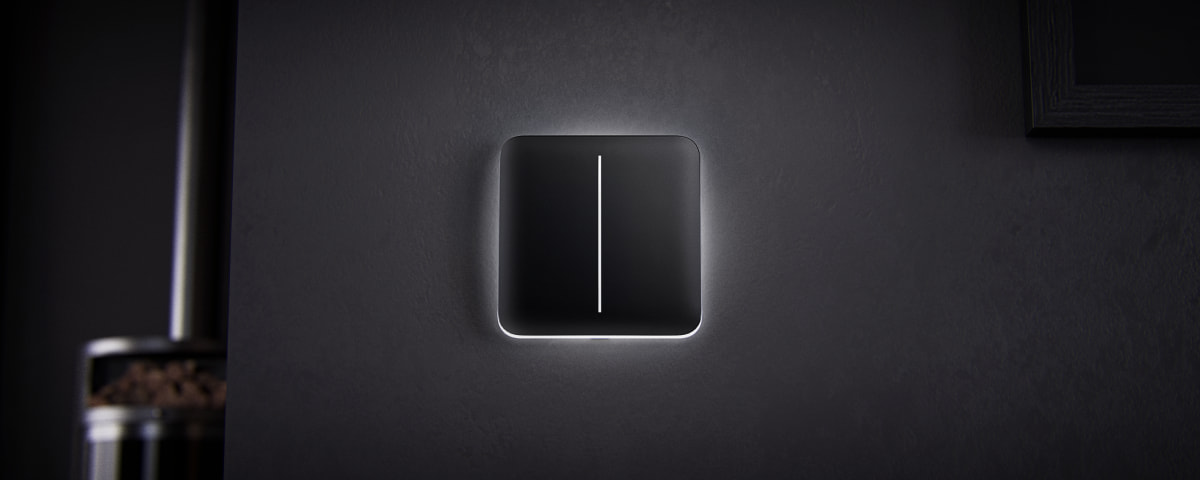
LightSwitch has a backlight that makes the switch visible in the dark. If the frame of the device is backlit, the light is off. When the light is on, the frame is not backlit. The backlight is not bright, so it will not disturb users even if the device is installed near a bed. The backlight can be turned off in the Ajax app if necessary.
If the temperature protection of LightSwitch is triggered or the touch-sensitive panel is removed, the switch flashes red every second.
To inform you that LightSwitch is not paired with the hub, it flashes green every second for one minute:
- when you connect LightSwitch to the power supply the first time;
- when you press and hold the LightSwitch button for at least 3 seconds.
Malfunctions
When a device identifies a fault (for example, there is no connection with the hub), the Ajax app displays a malfunction counter in the device field.
All malfunctions are shown in the switch states. Fields with malfunctions will be highlighted in red.
A malfunction is displayed if:
- Temperature protection was activated.
- A device with insufficient power is connected.
- An insufficient power supply is detected.
- There is no communication between LightSwitch and the hub (or range extender).
What to do in case of loss of communication with the device
LightSwitch may lose communication with the hub for the following reasons:
- Power is no longer supplied.
- The touch-sensitive panel has been removed (it has antennas on it, which are necessary for communication with the hub or range extender).
- The lighting device is faulty (for example, the incandescent lamp burned out).
- A device with insufficient power (up to 5 W) is connected.
- LightSwitch malfunction.
If an event about the loss of communication with the switch is received, the installer should check:
- Power supply of LightSwitch.
- Presence of a touch-sensitive panel on the switch.
- Operability of the lighting device.
If LightSwitch controls a lighting device with insufficient power (up to 5 W), it is necessary to replace the lighting device with a similar one with a higher power or connect a bundled capacitor in parallel with the lighting device.
Maintenance
Check the functioning of the switch regularly. Clean the enclosure from dust, cobwebs, and other contaminants as they emerge. Use a soft dry cloth suitable for equipment care. Do not use substances that contain alcohol, acetone, petrol, and other active solvents to clean the device.
Technical specifications
Complete set
LightSwitch is a prefabricated smart light switch. All parts are purchased separately.
Use the online Ajax switches and outlets configurator to assemble your custom set. Combine devices into a frame, pick the color, and download your configuration as PDF.
Warranty
The warranty for the products of the Limited Liability Company “Ajax Systems Manufacturing” is valid for 2 years after purchase.
If the device does not operate properly, we recommend contacting support service first, as in most cases, technical issues can be resolved remotely.
Contact Technical Support:
